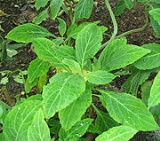
Psychedelic plants
Encyclopedia
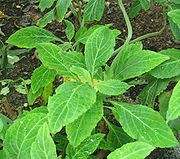
THC
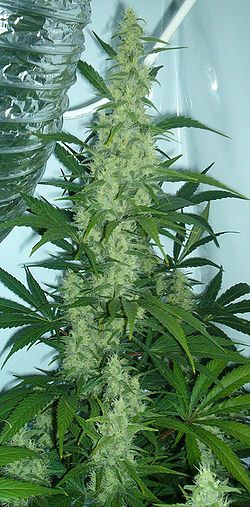
THC
THC commonly refers to tetrahydrocannabinol, the main active chemical compound in Cannabis.THC may also refer to:* Tan Holdings Corporation...
, which contains no nitrogen and is not an indole
Indole
Indole is an aromatic heterocyclic organic compound. It has a bicyclic structure, consisting of a six-membered benzene ring fused to a five-membered nitrogen-containing pyrrole ring. Indole is a popular component of fragrances and the precursor to many pharmaceuticals. Compounds that contain an...
, phenethylamine
Phenethylamine
Phenylethylamine or phenethylamine is a natural monoamine alkaloid, trace amine, and also the name of a class of chemicals with many members well known for psychoactive drug and stimulant effects. Studies suggest that phenylethylamine functions as a neuromodulator or neurotransmitter in the...
, anticholinergic
Anticholinergic
An anticholinergic agent is a substance that blocks the neurotransmitter acetylcholine in the central and the peripheral nervous system. An example of an anticholinergic is dicycloverine, and the classic example is atropine....
(deliriant), or a dissociative drug. Cannabis plants tend to vary, with different strains producing dynamic balances of psychoactive cannabinoids (THC, CBD, etc) that cause different strains to produce markedly different effects, popular strains often being hybrids of both Cannabis Sativa
Cannabis sativa
Cannabis sativa is an annual herbaceous plant in the Cannabaceae family. Humans have cultivated this herb throughout recorded history as a source of industrial fibre, seed oil, food, recreation, spiritual enlightenment and medicine...
and Cannabis Indica
Cannabis indica
Cannabis indica is an annual plant in the Cannabaceae family. A putative species of the genus Cannabis, it is typically distinguished from Cannabis sativa. Schultes described C. indica as relatively short, conical, and densely branched, whereas C. sativa was described as tall and laxly branched...
.
Currently, certain universities and research firms are studying the medicinal effects of cannabis. Many jurisdictions have laws regulating (or outright prohibiting) the sale and use of medical cannabis
Medical cannabis
Medical cannabis refers to the use of parts of the herb cannabis as a physician-recommended form of medicine or herbal therapy, or to synthetic forms of specific cannabinoids such as THC as a physician-recommended form of medicine...
to treat pain, insomnia, and stimulate appetite.
Tryptamines

Dimethyltryptamine
N,N-Dimethyltryptamine is a naturally occurring psychedelic compound of the tryptamine family. DMT is found in several plants, and also in trace amounts in humans and other mammals, where it is originally derived from the essential amino acid tryptophan, and ultimately produced by the enzyme INMT...
), which is either snorted (Virola, Yopo snuffs), smoked, or drunk with MAOIs (Ayahuasca
Ayahuasca
Ayahuasca is any of various psychoactive infusions or decoctions prepared from the Banisteriopsis spp. vine, usually mixed with the leaves of dimethyltryptamine-containing species of shrubs from the Psychotria genus...
). It cannot simply be eaten as it is not orally active without a MAOI and it needs to be extremely concentrated to be smokable.
- AcanthaceaeAcanthaceaeThe family Acanthaceae is a taxon of dicotyledonous flowering plants containing almost 250 genera and about 2500 species....
Species, Alkaloid content, where given, refers to dried material
- Fittonia albivenisFittonia albivenisFittonia albivenis is a garden plant in the family Acanthaceae notable for its dark green foliage. It is commonly called Nerve Plant or Mosaic Plant.-Growth:...
, a common ornamental plant from South America. It is useful in the treatment of headaches, etc.
- Justicia pectoralisJusticia pectoralisJusticia pectoralis is a herb of the Acanthus family . This water-willow is widely known as tilo in Latin America. In Haiti it is called chapantye and zeb chapantyè on Dominica and Martinique...
, DMT in leaves
- AceraceaeAceraceaeAceraceae is a family of flowering plants also called the Maple Family. It contains two to four genera, depending upon the circumscription, of some 120 species of trees and shrubs. A common characteristic is that the leaves are opposite, and the fruit a schizocarp.The maples have long been known...
- Acer saccharinum (Silver Maple Tree) was found to contain the indole alkaloid gramineGramineGramine is a naturally occurring indole alkaloid present in several plant species. Gramine may play a defensive role in these plants, since it is toxic to many organisms.-Occurrence:...
(not active and extremely toxic) 0.05% in the leaves, so it is possible that other members of this plant family contain active compounds.
- AizoaceaeAizoaceaeThe Family Aizoaceae or Ficoidaceae is a taxon of dicotyledonous flowering plants containing 135 genera and about 1900 species. They are commonly known as stone plants or carpet weeds. Species that resemble stones or pebbles are sometimes called mesembs...
- Delosperma acuminatum, DMT, 5-MEO-DMT
- Delosperma cooperiDelosperma cooperiDelosperma cooperi is a dwarf perennial plant, native to South Africa. It forms a dense lawn with abundant, long-lasting flowering...
, DMT, 5-MEO-DMT
- Delosperma ecklonis, DMT
- Delosperma esterhuyseniae, DMT
- Delosperma hallii, 5-MEO-DMT
- Delosperma harazianum, DMT, 5-MEO-DMT
Delosperma harazianum
Shibam, DMT
- Delosperma hirtum, DMT
Delosperma hallii
aff. litorale
- Delosperma lydenbergense, DMT, 5-MEO-DMT
- Delosperma nubigenum, 5-MEO-DMT
- Delosperma pageanum, DMT, 5-MEO-DMT
- Delosperma pergamentaceum, Traces of DMT
- Delosperma tradescantioides, DMT
- ApocynaceaeApocynaceaeThe Apocynaceae or dogbane family is a family of flowering plants that includes trees, shrubs, herbs, and lianas.Many species are tall trees found in tropical rainforests, and most are from the tropics and subtropics, but some grow in tropical dry, xeric environments. There are also perennial herbs...
- Prestonia amazonicaPrestonia amazonicaPrestonia amazonica is a hallucinogenic plant native to Amazon Rainforest vegetation. This plant is cited in Louisiana State Act 159....
: DMT
- Voacanga africanaVoacanga africanaVoacanga africana is a small tropical African tree that grows to 6m in height. It has leaves that are up to 30 cm in length, and the tree produces yellow or white flowers, which become berries with yellow seeds.- Uses :...
: Iboga alkaloidsIbogaineIbogaine is a naturally occurring psychoactive substance found in a number of plants, principally in a member of the Apocynaceae family known as Iboga . A hallucinogen with both psychedelic and dissociative properties, the substance is banned in some countries; in other countries it is being used...
- FabaceaeFabaceaeThe Fabaceae or Leguminosae, commonly known as the legume, pea, or bean family, is a large and economically important family of flowering plants. The group is the third largest land plant family, behind only the Orchidaceae and Asteraceae, with 730 genera and over 19,400 species...
(Leguminosae)
- Acacia acuminata, Up to 1.5% alkaloids, mainly consisting of dimethyltryptamineDimethyltryptamineN,N-Dimethyltryptamine is a naturally occurring psychedelic compound of the tryptamine family. DMT is found in several plants, and also in trace amounts in humans and other mammals, where it is originally derived from the essential amino acid tryptophan, and ultimately produced by the enzyme INMT...
in leaf
- Acacia alpinaAcacia alpinaAcacia alpina is an evergreen shrub 1 m to 2 m high and about 10 m wide.It is a close relative of Acacia phlebophylla and they tend to hybridize. It often can be found in alpine and subalpine areas of Australia....
, Active principles in leaf
- Acacia angustissimaAcacia angustissimaAcacia angustissima is a perennial, deciduous, shrub or tree in the Fabaceae family native to Central America and the United States. It is also found in South America, India and Pakistan. Other common names for it include Carboncillo, Timbe, Timbre, Fern Acacia and Prairie wattle...
, β-methyl-phenethylamine, NMT and DMT in leaf (1.1-10.2 ppm)
- Acacia aromaAcacia aromaAcacia aroma is a small, perennial, thorny tree native to Bolivia, Peru, Argentina and Paraguay. Some common names for it are Aromita, Aromo Negro, Espinillo and Tusca. It is not listed as being a threatened species....
, Tryptamine alkaloids. Significant amount of tryptamine in the seeds.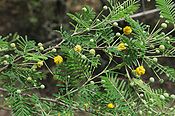
- Acacia auriculiformisAcacia auriculiformisAcacia auriculiformis, commonly known as Auri, Earleaf acacia, Earpod wattle, Northern black wattle, Papuan wattle, Tan wattle, is a fast-growing, crooked, gnarly tree in the family Fabaceae. It is native to Australia, Indonesia, and Papua New Guinea. It grows up to 30m tall...
, 5-MeO-DMT in stem bark
- Acacia acuminata, 0.6-1.5% DMT in bark (var. net ref.)
- Acacia baileyanaCootamundra wattleAcacia baileyana, commonly known as Cootamundra Wattle, is a shrub or tree in the genus Acacia. The scientific name of the species honours the botanist Frederick Manson Bailey. It is indigenous to a small area of southern New South Wales in Australia, but it has been widely planted in other...
, 0.02% tryptamine and β-carbolines, in the leaf, TetrahydroharmanTetrahydroharmanTetrahydroharman, also known as 1-methyl-1,2,3,4-tetrahydro-β-carboline, is a general name for one of two isomers:# -1-methyl-2,3,4,9-tetrahydro-1H-pyrido[3,4-b]indole# Calligonine...
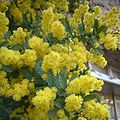
- Acacia beauverdianaAcacia beauverdianaAcacia beauverdiana is a perennial tree 1 m to 8 m tall with multiple stems. It has yellow flowers and it blooms from July to October. It is native to Western Australia.- External links :*...
, Psychoactive Ash used in Pituri.
- Acacia berlandieriAcacia berlandieriAcacia berlandieri is a shrub native to the Southwestern United States and northeast Mexico that belongs to the subfamily Mimosoideae of Fabaceae . It grows tall, with blossoms that are spherical and white, occurring from February through April...
, DMT, amphetamines, mescalineMescalineMescaline or 3,4,5-trimethoxyphenethylamine is a naturally occurring psychedelic alkaloid of the phenethylamine class used mainly as an entheogen....
, nicotineNicotineNicotine is an alkaloid found in the nightshade family of plants that constitutes approximately 0.6–3.0% of the dry weight of tobacco, with biosynthesis taking place in the roots and accumulation occurring in the leaves...

- Acacia catechuAcacia catechuAcacia catechu also commonly called Mimosa catechu, is a deciduous, thorny tree which grows up to in height. The plant is called khair in Hindi, and kachu in Malay, hence the name was Latinized to "catechu" in Linnaean taxonomy, as the type-species from which the extracts cutch and catechu are...
, DMT and other tryptamines in leaf, bark
- Acacia cavenAcacia cavenAcacia caven is an ornamental tree in the Fabaceae family. Acacia caven is native to Argentina, Bolivia, Chile, Paraguay, and Uruguay...
, Psychoactive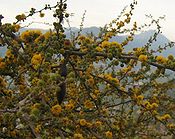
- Acacia chundraAcacia chundraAcacia chundra is a perennial, deciduous tree found in Asia, India and in the Indian Ocean area. It grows 12 m to 15 m in height.Common names for it include Karangali, Kodalimurunkai, Lal Khair, Lal Khair, Rat Kihiriya and Red Cutch.Its uses include chemical products, medicine and wood.- Uses :The...
, DMT and other tryptamines in leaf, bark
- Acacia coleiAcacia coleiAcacia colei is a perennial bush or tree native to Australia and southern Asia. A common name for it is Cole's Wattle.It grows to a height of up to 9 m. Acacia colei blooms from June through July and the flowers are bright yellow.- Uses :...
, DMT
- Acacia complanataAcacia complanataAcacia complanata, generally known as Long-pod Wattle and Flat-stemmed Wattle, is a perennial tree native to Australia. It can grow 5–6 m tall, but more often it grows as a large shrub. It is not listed as being a threatened species...
, 0.3% alkaloids in leaf and stem, almost all N-methyl-tetrahydroharman, with traces of tetrahydroharman, some of tryptamine
- Acacia confusaAcacia confusaAcacia confusa is a perennial tree native to South-East Asia. Some common names for it are Acacia Petit Feuille, Small Philippine Acacia, Formosa Acacia and Formosan Koa. It grows to a height of 15m...
, DMT & NMT in leaf, stem & bark 0.04% NMT and 0.02% DMT in stem. Also N,N-dimethyltryptamine N-oxide
- Acacia cornigeraAcacia cornigeraAcacia cornigera, commonly known as Bullhorn Acacia , is a swollen-thorn acacia native to Mexico and Central America. The common name of "bullhorn" refers to the enlarged, hollowed-out, swollen thorns that occur in pairs at the base of leaves, and resemble the horns of a steer...
, Psychoactive, Tryptamines
- Acacia cultriformisAcacia cultriformisAcacia cultriformis, known as the Knife-leaf Wattle, Dogtooth Wattle, Half-moon Wattle or Golden-glow Wattle, is a perennial tree or shrub of the genus Acacia native to Australia. It is widely cultivated, and has been found to have naturalised in Asia, Africa, North America, New Zealand and South...
, Tryptamine, in the leaf, stem and seeds. Phenethylamine in leaf and seeds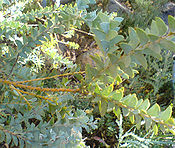
- Acacia cuthbertsoniiAcacia cuthbertsoniiAcacia cuthbertsonii is a perennial shrub or tree native to Australia. It grows 1–5 m tall with fissured, flaky bark. It grows in the central western part of Australia.- Uses :...
, Psychoactive
- Acacia decurrensAcacia decurrensAcacia decurrens is a perennial tree or shrub native to eastern New South Wales...
, Psychoactive, but less than 0.02% alkaloids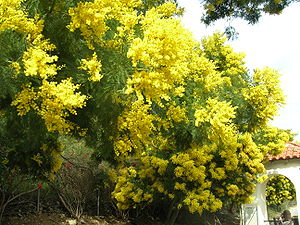
- Acacia delibrataAcacia delibrataAcacia delibrata is a perennial tree native to Western Australia. It grows narrowly upward to a height of 2-8m. It flowers from March to August. It is not listed as being a threatened species....
, Psychoactive
- Acacia falcataAcacia falcataAcacia falcata, commonly known as sickle wattle and by other vernacular names including sally, is a perennial shrub or tree native to eastern Australia, which reaches five metres in height and has cream flowers in early winter. It gets its common and scientific name for its sickle-shaped leaves...
, Psychoactive, but less than 0.02% alkaloids
- Acacia farnesiana, Traces of 5-MeO-DMT in fruit. β-methyl-phenethylamine, flower. Ether extracts about 2-6% of the dried leaf mass. Alkaloids are present in the bark and leaves. Amphetamines and mescaline also found in tree.

- Acacia floribundaAcacia floribundaAcacia floribunda is a perennial evergreen shrub or tree. It is native to New South Wales, Queensland and Victoria, but is cultivated extensively, and has naturalised in South Australia, Tasmania and Western Australia, and also in Indonesia, Mauritius and northern New Zealand...
, Tryptamine, phenethylamine, in flowers other tryptamines,DMT,tryptamine,NMT 0.3-0.4% phyllodes.
- Acacia georginaeAcacia georginaeAcacia georginae is a perennial tree which is native to Australia and which has been introduced into the United States. Common names for it include Georgina Gidgee, Georgina Gidyea and Poison Gidyea...
, Psychoactive, plus deadly toxins
- Acacia horridaAcacia horridaAcacia horrida is a low spreading shrub or sometimes tree native to both the wet and dry scrublands of tropical to subtropical East Africa. Common names for it are Cape Gum and Dev-Babul. It is also found elsewhere in Africa, Asia, India and South America. It frequently has stipular spines...
, Psychoactive
- Acacia implexaAcacia implexaAcacia implexa is an Australian Acacia, used for furniture making. Its common name is Lightwood....
, Psychoactive
- Acacia juremaAcacia juremaAcacia jurema is a tree native to Brazil. Its name comes from a city in Brazil called Jurema and it may sometimes be used in Jurema wine, a variety of Ayahuasca used by some of the indigenous people of Brazil....
, DMT, NMT
- Acacia karrooAcacia karrooAcacia karroo also known as the Sweet Thorn, is a species of Acacia, native to southern Africa from southern Angola east to Mozambique, and south to South Africa....
, Psychoactive
- Acacia laetaAcacia laetaAcacia laeta, commonly known as the Gay Acacia, is in the Acacia family.-Description:It is a perennial shrub or tree growing to a height of 4-10m...
, DMT, in the leaf
- Acacia longifoliaAcacia longifoliaAcacia longifolia is a species of Acacia native to southeastern Australia, from the extreme southeast of Queensland, eastern New South Wales, eastern and southern Victoria, and southeastern South Australia. Common names for it include Acacia Trinervis, Aroma Doble, Golden Wattle, Coast Wattle,...
, 0.2% tryptamine in bark, leaves, some in flowers, phenylethylamine in flowers, 0.2% DMT in plant. Histamine alkaloids.Acacia longifolia var. sophorae, Tryptamine in leaves, bark
- Acacia macradenia, Tryptamine
- Acacia maideniiAcacia maideniiAcacia maidenii, also known as Maiden's Wattle, is a tree native to Australia . It has been introduced into India and Argentina, and it grows on plantations in South Africa. It prefers full sun to partial shade and it is often found on the edge of the rainforest. It grows up to 15 m in height...
, 0.6% NMT and DMT in about a 2:3 ratio in the stem bark, both present in leaves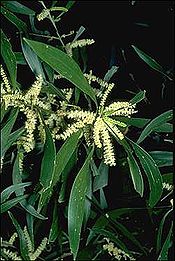
- Acacia mangiumAcacia mangiumAcacia mangium is a species of flowering tree in the pea family, Fabaceae, that is native to northeastern Queensland in Australia, the Western Province of Papua New Guinea, Papua, and the eastern Maluku Islands. Common names include Black Wattle, Hickory Wattle and Mangium...
, Psychoactive
- Acacia melanoxylon, DMT, in the bark and leaf, but less than 0.02% total alkaloids

- Acacia melliferaAcacia melliferaAcacia mellifera is a perennial tree which is listed as being not threatened. The name mellifera refers to its sweet-smelling blossoms and honey. Its lumber turns pitch black when oiled...
, DMT, in the leaf
- Acacia niloticaAcacia niloticaAcacia nilotica is a species of Acacia native to Africa and the Indian subcontinent...
, DMT, in the leaf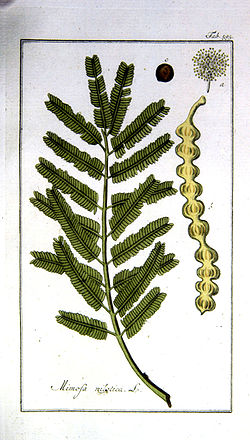
- Acacia nilotica subsp. adstringensAcacia nilotica subsp. adstringensAcacia nilotica subsp. adstringens is a perennial tree. It is not listed as being threatened. Some common names for it are Cassie, Piquants Blancs and Piquant Lulu. Its geographic distribution includes Africa, Asia, the Indian Ocean area and the Middle East.Acacia nilotica subsp...
, Psychoactive, DMT in the leaf
- Acacia obtusifoliaAcacia obtusifoliaAcacia obtusifolia is a perennial tree in subfamily Mimosoideae of family Fabaceae.- Description :Acacia obtusifolia is an upright or spreading perennial tree which grows from 1.5m to 8m in height and it is native to Australia. It is closely related to Acacia longifolia...
, Tryptamine, DMT, NMT, other tryptamines, 0.4-0.5% in dried bark,0.15-0.2% in leaf, 0.07% in branch tips.
- Acacia oerfotaAcacia oerfotaAcacia oerfota is a perennial shrub or tree which is native to Africa, Asia and the Middle East. Among other things, it is used in making beverages.It grows 1-5m high....
, Less than 0.1% DMT in leaf, NMT
- Acacia penninervisAcacia penninervisAcacia penninervis is a perennial shrub or tree 2-8m high, which is native to Australia and New Zealand.Common names for it are Hickory Wattle and Mountain Hickory....
, Psychoactive
- Acacia phlebophyllaAcacia phlebophyllaAcacia phlebophylla, an Acacia also known by the names Buffalo Sallow Wattle and Mountain Buffalo Wattle, is a straggling shrub to small, twisted tree reaching up to 5 meters in height. It is a close relative of Acacia alpina...
, 0.3% DMT in leaf, NMT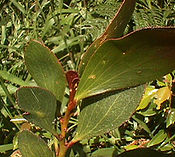
- Acacia podalyriaefolia, Tryptamine in the leaf, 0.5% to 2% DMT in fresh bark, phenethylamine, trace amounts. Although this species is claimed to contain 0.5% to 2% DMT in fresh bark the reference for this is invalid as there is no reference to Acacia Podalyriffolia anywhere in the reference article. Additionally, well known and proven extraction techniques for DMT have failed to produce any DMT or alkaloids from fresh bark or the leaves on multiple sample taken at various seasons. Should DMT actually exist in this species of Acacia then it exists in extremely small amounts and have failed to produce any alkaloids with Acid/Base extraction techniques using HCl/Na(OH)2. On the same note, more academic research is definitely required into the DMT content of this and other Australian Acacia species with proper chemical analysis of sample.

- Acacia polyacanthaAcacia polyacanthaAcacia polyacantha, also known as White Thorn is a flowering tree which can grow up to 25m tall. Polyacantha has the meaning "many thorns" in Latin. The tree is native to Africa, India, the Indian Ocean and Asia, but it has also been introduced to the Caribbean.-Repellent uses:The root of Acacia...
, DMT in leaf and other tryptamines in leaf, bark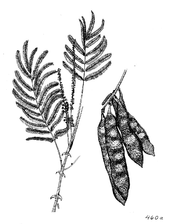
- Acacia polyacantha ssp. campylacantha, Less than 0.2% DMT in leaf, NMT; DMT and other tryptamines in leaf, bark
- Acacia rigidulaAcacia rigidulaAcacia rigidula, commonly known as Blackbrush Acacia or Chaparro Prieto, is a species of shrub or small tree in the legume family, Fabaceae. Its native range stretches from Texas in the United States south to central Mexico. This perennial is closely related to A. berlandieri and is not listed as...
, DMT, NMT, tryptamine, traces of amphetamines, mescaline, nicotine and others
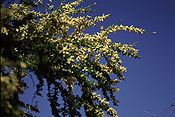
- Acacia sassaAcacia sassaAcacia sassa grows in the forests of Senegal. Smoke from certain parts of it is known to be psychoactive....
, Psychoactive
- Acacia schaffneriAcacia schaffneriAcacia schaffneri is a tree native to Mexico and the United States .-Uses:Acacia schaffneri wood is used for fuel and fences. The wood makes very good firewood. It is used for cooking....
, β-methyl-phenethylamine, PhenethylaminePhenethylaminePhenylethylamine or phenethylamine is a natural monoamine alkaloid, trace amine, and also the name of a class of chemicals with many members well known for psychoactive drug and stimulant effects. Studies suggest that phenylethylamine functions as a neuromodulator or neurotransmitter in the...
Amphetamines and mescaline also found.
- Acacia senegalAcacia senegalis a small deciduous Acacia tree known by the common names Rfaudraksha, Gum Acacia, Gum Arabic Tree, or Gum Senegal Tree. It is native to semi-desert regions of Sub-Saharan Africa, as well as Oman, Pakistan, and northwestern India. It grows to a height of 5-12m, with a trunk up to 30 cm in...
, Less than 0.1% DMT in leaf, NMT, other tryptamines. DMT in plant, DMT in bark.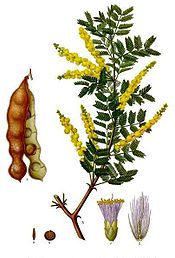
- Acacia seyalAcacia seyalAcacia seyal, the Red acacia, known also as the shittah tree , is a thorny, 6–10 m high tree with a pale greenish or reddish bark. At the base of the 3–10 cm feathery leaves there are two straight, light grey thorns, growing to 7–20 cm long...
, DMT, in the leaf. Ether extracts about 1-7% of the dried leaf mass.
- Acacia sieberianaAcacia sieberianaAcacia sieberiana is a perennial tree native to Africa and introduced into Pakistan. It is known in South Africa as the Paperbark Thorn.This tree grows 3–25 m in height, with a trunk diameter of 0.6–1.8 m....
, DMT, in the leaf
- Acacia simplexAcacia simplexAcacia simplex is a perennial climbing tree native to islands in the western part of the Pacific Ocean as far east as Savaii. It is also found in Argentina...
, DMT and NMT, in the leaf, stem and trunk bark, 0.81% DMT in bark, MMT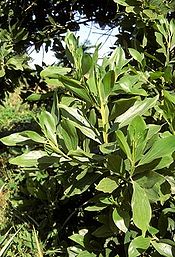
- Acacia tortilisAcacia tortilisAcacia tortilis, the Umbrella Thorn Acacia, also known as Umbrella Thorn and Israeli Babool, is a medium to large canopied tree native primarily to the savanna and Sahel of Africa , but also occurring in the Middle East....
, DMT, NMT, and other tryptamines
- Acacia vestitaAcacia vestitaAcacia vestita, with common names Weeping Boree, Weeping Acacia, and Hairy Wattle, is a shrub and small tree native to New South Wales, Australia. -Description:...
, Tryptamine, in the leaf and stem, but less than 0.02% total alkaloids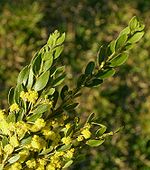
- Acacia victoriaeAcacia victoriaeAcacia victoriae commonly known as Gundabluie or Bardi bush is a shrub or tree native to Australia. It grows 2–5 m, sometimes 9 m tall. It has spines 2–12 mm in length.Subspecies:A. victoriae subsp. arida Pedley-Uses:...
, Tryptamines, 5-MeO-alkyltryptamine
- List of Acacia Species Having Little or No Alkaloids in the Material Sampled:
(0% C 0.02%, Concentration of Alkaloids)
- Acacia acinaceaAcacia acinaceaAcacia acinacea is a flowering shrub growing to 2m in height. It is native to Australia and lives for 15 years . They are tolerant of drought and frost. It is also a species of wattle, and is commonly known as Wreath Wattle, Gold Dust Wattle or Round-leaf Wattle.They are a hardy, free-flowering...
- Acacia baileyana
- Acacia decurrensAcacia decurrensAcacia decurrens is a perennial tree or shrub native to eastern New South Wales...
- Acacia dealbataAcacia dealbataAcacia dealbata is a species of Acacia, native to southeastern Australia in New South Wales, Victoria, Tasmania, and the Australian Capital Territory.-Description:...
- Acacia mearnsii
- Acacia drummondiiAcacia drummondiiAcacia drummondii is a perennial tree endemic to Western Australia....
- Acacia elataAcacia elataAcacia elata the Cedar Wattle or Mountain Cedar Wattle is a tree found in eastern Australia. Often up to 18 metres tall when mature, exceptional specimens reach over 30 metres. The habitat is near rainforest and wet sclerophyll forest in various situations. An attractive plant with delicate...
- Acacia falcataAcacia falcataAcacia falcata, commonly known as sickle wattle and by other vernacular names including sally, is a perennial shrub or tree native to eastern Australia, which reaches five metres in height and has cream flowers in early winter. It gets its common and scientific name for its sickle-shaped leaves...
- Acacia leprosaAcacia leprosaAcacia leprosa, also known as Cinnamon Wattle, is an acacia native to Australia. It occurs in woodland in New South Wales and Victoria. It occurs as a hardy shrub or small tree. The phyllodes are 3-14 cm long and contain oil glands...
- Acacia linearis
- Acacia melanoxylon
- Acacia pycnantha
- Acacia retinodesAcacia retinodesAcacia elongata is a perennial tree which is widely distributed throughout the world. It is unusual amongst the Acacias, since it flowers the whole year round...
- Acacia salignaAcacia salignaAcacia saligna, commonly known by various names including coojong, golden wreath wattle, orange wattle, blue-leafed wattle, Western Australian golden wattle, and, in Africa, Port Jackson willow, is a small tree in the family Fabaceae...
- Acacia strictaAcacia strictaAcacia stricta is a perennial tree....
- Acacia verticillataAcacia verticillataAcacia verticillata is a perennial tree....
- Acacia vestitaAcacia vestitaAcacia vestita, with common names Weeping Boree, Weeping Acacia, and Hairy Wattle, is a shrub and small tree native to New South Wales, Australia. -Description:...
- Albizia inundataAlbizia inundataAlbizia inundata is a perennial tree native to South America. Common names include maloxo, muqum, paloflojo, Timbo Blanco, Timbo-ata, and also "canafistula" though this usually is Golden Shower Tree ....
leaves contain DMT.
- Anadenanthera colubrina,
BufoteninBufoteninBufotenin , or 5-hydroxy-dimethyltryptamine , is a tryptamine related to the neurotransmitter serotonin...
, Beans, Bufotenin oxide, Beans, N,N-DimethyltryptamineDimethyltryptamineN,N-Dimethyltryptamine is a naturally occurring psychedelic compound of the tryptamine family. DMT is found in several plants, and also in trace amounts in humans and other mammals, where it is originally derived from the essential amino acid tryptophan, and ultimately produced by the enzyme INMT...
, Beans, pods,
- Anadenanthera colubrina var. cebilAnadenanthera colubrina var. cebilAnadenanthera colubrina var. cebil Altschul is a mimosa-like timber tree native to Caatinga and Cerrado vegetation in Argentina, Bolivia, Brazil, Paraguay and Peru. It has also been introduced to Mauritius. It grows up to 25 m tall, with a trunk diameter of 60-90 cm. The tree's...
- BufoteninBufoteninBufotenin , or 5-hydroxy-dimethyltryptamine , is a tryptamine related to the neurotransmitter serotonin...
and DimethyltryptamineDimethyltryptamineN,N-Dimethyltryptamine is a naturally occurring psychedelic compound of the tryptamine family. DMT is found in several plants, and also in trace amounts in humans and other mammals, where it is originally derived from the essential amino acid tryptophan, and ultimately produced by the enzyme INMT...
have been isolated from the seeds and seed pods, 5-MeO-DMT5-MeO-DMT5-MeO-DMT is a powerful psychedelic tryptamine. It is found in a wide variety of plant and psychoactive toad species and, like its close relatives DMT and bufotenin , it has been used as an entheogen by South American shamans for thousands of years.-Chemistry:5-MeO-DMT was first synthesized in...
from the bark of the stems. The seeds were found to contain 12.4% bufotenine, 0.06% 5-MeO-DMT and 0.06% DMTDimethyltryptamineN,N-Dimethyltryptamine is a naturally occurring psychedelic compound of the tryptamine family. DMT is found in several plants, and also in trace amounts in humans and other mammals, where it is originally derived from the essential amino acid tryptophan, and ultimately produced by the enzyme INMT...
.
- Anadenanthera peregrina,
1,2,3,4-Tetrahydro-6-methoxy-2,9-dimethyl-beta-carbolineBeta-carbolineβ-Carboline is an organic amine that is the prototype of a class of compounds known as β-carbolines.-Pharmacology:...
, Plant, 1,2,3,4-Tetrahydro-6-methoxy-2-methyl-beta-carboline, Plant, 5-Methoxy-N,N-dimethyltryptamine5-MeO-DMT5-MeO-DMT is a powerful psychedelic tryptamine. It is found in a wide variety of plant and psychoactive toad species and, like its close relatives DMT and bufotenin , it has been used as an entheogen by South American shamans for thousands of years.-Chemistry:5-MeO-DMT was first synthesized in...
, Bark, 5-Methoxy-N-methyltryptamine, Bark, BufoteninBufoteninBufotenin , or 5-hydroxy-dimethyltryptamine , is a tryptamine related to the neurotransmitter serotonin...
, plant, beans, BufoteninBufoteninBufotenin , or 5-hydroxy-dimethyltryptamine , is a tryptamine related to the neurotransmitter serotonin...
N-oxide, Fruit, beans, N,N-Dimethyltryptamine-oxide, Fruit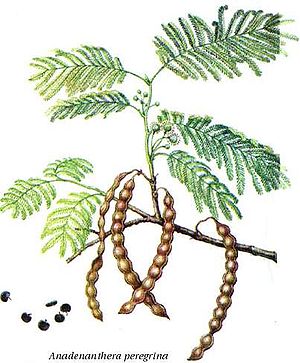
- Anadenanthera peregrina var. peregrinaAnadenanthera peregrina var. peregrinaAnadenanthera peregrina var. peregrina is a tree in the Fabaceae family. It is native to Guyana, Venezuela, Brazil, Colombia and it is also found in the Caribbean.-Entheogen:In South America, Anadenanthera peregrina var...
,
Bufotenine is in the seeds.
- Desmanthus illinoensisDesmanthus illinoensisDesmanthus illinoensis is a plant in many areas of the south central US.Root bark of D...
, 0% - 0.34% DMT in root bark, highly variable. Also NMTN-MethyltryptamineN-Methyltryptamine , or methyltryptamine, is a member of the tryptamine chemical class. It is an alkaloid, probably derived from L-tryptophan, that has been found in the bark, shoots and leaves of several plant species, including Virola, Acacia, Mimosa and Desmanthus often together with the...
, N-hydroxy-N-methyltryptamine, 2-hydroxy-N-methyltryptamine, and gramineGramineGramine is a naturally occurring indole alkaloid present in several plant species. Gramine may play a defensive role in these plants, since it is toxic to many organisms.-Occurrence:...
(toxic).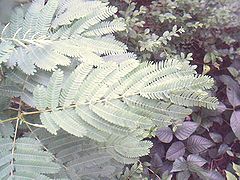
- Desmanthus leptolobusDesmanthus leptolobusDesmanthus leptolobus is an inconspicuous and more or less prostrate plant of the genus Desmanthus. It can be found growing wild in many areas of the south central US...
, 0.14% DMT in root bark, more reliable than D. illinoensis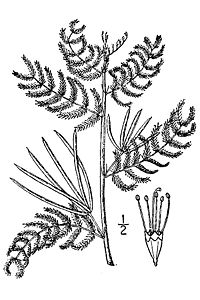
- Desmodium caudatumDesmodium caudatumDesmodium caudatum is a deciduous nitrogen fixing plant in the Fabaceae family. It is found in India, China and other parts of Asia. The shrub grows to a height of about 1.5 m tall. The leaves and roots of the plant are used as an insecticide....
(syn. Ohwia caudata ), Roots: 0.087% DMT,
- Desmodium intortum, Bufotentine, DMT
- Codariocalyx motoriusCodariocalyx motoriusCodariocalyx motorius , known as the Telegraph Plant or Semaphore Plant, is a tropical Asian shrub, one of a few plants capable of rapid movement; others include Mimosa pudica and the Venus Flytrap....
(syn. Desmodium gyrans), DMT, 5-MEO-DMT, leaves, roots
- Desmodium racemosum, 5-MEO-DMT
- Desmodium triflorumDesmodium triflorumDesmodium triflorum is an ornamental plant in the Fabaceae family....
, 0.0004% DMT-N-oxide, roots, less in stems and trace in leaves.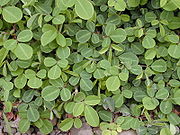
- Lespedeza capitata,
- Lespedeza bicolorLespedeza bicolorLespedeza bicolor is a species of flowering plant in the legume family known by the common names shrubby bushclover, shrub lespedeza, and bicolor lespedeza. It is native to Asia and it is widely grown as an ornamental plant...
, DMT, 5-MEO-DMT in leaves and roots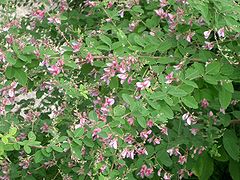
- Lespedeza bicolor var. japonica, DMT, 5-MEO-DMT in leaves and root bark
- Mimosa ophthalmocentraMimosa ophthalmocentraMimosa ophthalmocentra, Jurema-embira is a tree in the Fabaceae family. It is native to Brazil. It is shrub or small tree about 3 to 5 m tall. Its blossoms come in long, narrow cylindrical spikes having yellowish white petals and a white stamen. The blossoms are sometimes found to have a...
, Dried root: DMT 1.6%, NMT 0.0012% and hordenine 0.0065%
- Mimosa scabrellaMimosa scabrellaMimosa scabrella is a tree in the Fabaceae family. It is very fast growing and it can reach a height of 15 m tall in only 3 years. Its trunk is about 0.1-0.5 m in diameter. It has yellow flowers. The tree's seeds number about 65,000–70,000 seeds/kg.-Uses:Before the advent of the diesel...
, Tryptamine, NMT, DMT and N-methyltetrahydrocarboline in bark
- Mimosa somniansMimosa somniansMimosa somnians is a tree in the Fabaceae family. It is native to the Caribbean, Central America and South America. It is a short, low lying shrub with minuscule thorns lining its stems like hairs. Its leaves are sensitive, meaning that, when touched, they close quickly, similarly to Mimosa pudica...
, Trytamines and MMT
- Mimosa tenuiflora(syn. "Mimosa hostilis"), 0.31-0.57% DMTDimethyltryptamineN,N-Dimethyltryptamine is a naturally occurring psychedelic compound of the tryptamine family. DMT is found in several plants, and also in trace amounts in humans and other mammals, where it is originally derived from the essential amino acid tryptophan, and ultimately produced by the enzyme INMT...
(dry root bark).Mimosa verrucosa Mimosa verrucosaMimosa verrucosa, Jurema Branca or Jurema De Oieras is a species of legume in the Fabaceae family.It is a shrub or small tree native to Brazil...
Mimosa verrucosaMimosa verrucosa, Jurema Branca or Jurema De Oieras is a species of legume in the Fabaceae family.It is a shrub or small tree native to Brazil...
, DMT in root bark
- Mucuna pruriensMucuna pruriensMucuna pruriens is a tropical legume known as velvet bean or cowitch and by other common names , found in Africa, India and the Caribbean. The plant is infamous for its extreme itchiness produced on contact, particularly with the young foliage and the seed pods...
, "The leaves, seeds, stems and roots contain L-Dopa, Serotonin, 5-HTP, and Nicotine, as well as N,N-DMT, Bufotenine, and 5-MeO-DMT."
- Petalostylis casseoides, 0.4-0.5% tryptamine, DMT, etc. in leaves and stems
- Petalostylis labicheoides var. casseoides, DMT in leaves and stems
- Phyllodium pulchellumPhyllodium pulchellumPhyllodium pulchellum is a plant in the Fabaceae family....
(syn. Desmodium pulchellum), 0.2% 5-MeO-DMT, small quantities of DMT DMT (dominates in seedlings and young plants), 5-MEO-DMT (dominates in mature plant), whole plant, roots, stems, leaves, flowers
- Erythrina flabelliformis, other ErythrinaErythrinaErythrina is a genus of flowering plants in the pea family, Fabaceae. It contains about 130 species, which are distributed in tropical and subtropical regions worldwide. They are trees, growing up to in height...
species, seeds contain the alkaloids Erysodin and Erysovin
- CaesalpinioideaeCaesalpinioideaeCaesalpinioideae is a botanical name at the rank of subfamily, placed in the large family Fabaceae or Leguminosae. Its name is formed from the generic name Caesalpinia....
subfamily
- Petalostylis cassioides: 0.4-0.5% tryptamine, DMT, etc. in leaves and stems
- Petalostylis labicheoides, Tryptamines in leaves and stems, MAO's up to 0.5%
- LauraceaeLauraceaeThe Lauraceae or Laurel family comprises a group of flowering plants included in the order Laurales. The family contains about 55 genera and over 3500, perhaps as many as 4000, species world-wide, mostly from warm or tropical regions, especially Southeast Asia and South America...
- Nectandra megapotamica, NMT
- MalpighiaceaeMalpighiaceaeMalpighiaceae is a family of flowering plants in the order Malpighiales. It comprises approximately 75 genera and 1300 species, all of which are native to the tropics and subtropics...
- Diplopterys cabreranaDiplopterys cabreranaDiplopterys cabrerana is a South American rainforest vine, commonly known as Chaliponga, Chagropanga and, in parts of Ecuador, Chacruna...
: DMT 0.17-1.74%, average of 0.47% DMT
- MyristicaceaeMyristicaceaeMyristicaceae is the botanical name for a family of flowering plants. The family has been recognised by most taxonomists; it is sometimes called the "nutmeg family", after its most famous member, Nutmeg ....
- Horsfieldia superbaHorsfieldia superbaHorsfieldia superba is a species of plant in the Myristicaceae family. It is found in Indonesia, Malaysia, and Singapore, and is threatened by habitat loss...
: 5-MeO-DMT and beta-carbolines
- Iryanthera macrophylla: 5-MeO-DMT in bark
- Iryanthera ulei: 5-MeO-DMT in bark
- Osteophloem platyspermum: DMT, 5-MeO-DMT in bark
- Virola calophyllaVirola calophyllaVirola calophylla is a species of tree in the Myristicaceae family. It is native to Central America and South America, namely Panama,Guyana, Suriname, Brazil, Bolivia, Colombia , Ecuador and Peru .The tree grows 5-25 m tall...
, Leaves 0.149% DMT, leaves 0.006% MMT 5-MeO-DMT in bark
- Virola callophylloideaVirola callophylloideaVirola callophylloidea is a species of tree in the Myristicaceae family....
, DMT
- Virola carinataVirola carinataVirola carinata is a New World, tropical evergreen tree in the Myristicaceae family that is indigenous to Colombia, Venezuela and Brazil . It grows to a height of about 30m and its fruit is subglobular, 16-20 mm long and 17-19 mm in diameter, found in groups of 4 to 12....
, DMT in leaves
- Virola cuspidataVirola cuspidataVirola cuspidata is a species of tree in the Myristicaceae family....
, DMT
- Virola divergensVirola divergensVirola divergens is a species of tree in the Myristicaceae family. It grows to about 25m tall. The fruits are ellipsoidal and subglobular, 18-38 mm long and 16-33 mm in diameter, grouped 4 to 8....
, DMT in leaves
- Virola elongataVirola elongataVirola elongata is a species of tree in the Myristicaceae family. The tree is native to Panama, Guyana, Brazil , Bolivia, Colombia, Ecuador and Peru. It is also found in Suriname...
(syn. Virola theiodora), DMT, 5-MEO-DMT in bark, roots, leaves and flowers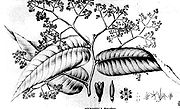
- Virola melinoniiVirola melinoniiVirola melinonii is a species of tree in the Myristicaceae family....
, DMT in bark
- Virola multinerviaVirola multinerviaVirola multinervia is a species of tree in the Myristicaceae family. It is found in Colombia, Peru, Ecuador, Venezuela and Brazil . It grows to a height of about 35m. The fruit is ellipsoidal to ovoidal, 26-40 mm long, 19-32 mm in diameter, and is found in groups of 1 to 7....
, DMT, 5-MEO-DMT in bark and roots
- Virola pavonisVirola pavonisVirola pavonis is a species of tree in the Myristicaceae family. It is found in Brazil , Colombia, Ecuador, Peru and Venezuela.The tree grows to a height of about 15-30m tall.-Fruit & Flowers:...
, DMT in leaves
- Virola peruvianaVirola peruvianaVirola peruviana is a species of tree in the Myristicaceae family. It is found in Brazil , Colombia, Ecuador and Peru. It grows to a height of about 35 m . The fruit is ellipsoidal, 14-24 mm long and 11-23 mm in diameter, forming groups of about 5 to 15....
, 5-MEO-DMT, traces of DMT and 5-MeO-tryptamine in bark
- Virola rufulaVirola rufulaVirola rufula is a species of tree in the Myristicaceae family.The tree contains alkaloids in its bark, leaves and roots. 5-methoxy-dimethyltryptamine makes up 95% of the alkaloids. There is about 0.190% 5-MeO-DMT in bark, 0.135% 5-MeO-DMT in root, and 0.092% dimethyltryptamine in the leaves....
, Alkaloids in bark and root, 95% of which is MeO-DMT 0.190% 5-MeO-DMT in bark, 0.135% 5-MeO-DMT in root, 0.092% DMT in leaves.
- Virola sebiferaVirola sebiferaVirola sebifera,also known as Myristica sebifera, common names Ucuúba-do-Cerrado and red ucuuba, is a type of tree from the family Myristicaceae, from Central America and South America...
, The bark contains 0.065% to 0.25% alkaloids, most of which are DMT and 5-MeO-DMT.
- Virola surinamensisVirola surinamensisVirola surinamensis is a species of plant in the Myristicaceae family. It is found in Brazil, Costa Rica, Ecuador, French Guiana, Guyana, Panama, Peru, Suriname, and Venezuela. It has also been naturalized in the Caribbean...
, DMT in bark
- Virola venosaVirola venosaVirola venosa is a species of tree in the Myristicaceae family. It is found in Colombia, Venezuela and Brazil . It grows 5-30 m tall....
, DMT, 5-MEO-DMT in roots, leaves DMT
- OchnaceaeOchnaceaeThe family Ochnaceae, or wild plane family, comprises mainly trees or shrubs, and more rarely herbaceous plants. Species of the Ochnaceae are found from subtropical to tropical regions. They are best represented in South America...
- Testulea gabonensisTestulea gabonensisTestulea gabonensis is a species of plant in the Ochnaceae family. It is found in Cameroon, the Republic of the Congo, Equatorial Guinea, and Gabon. It is threatened by habitat loss.-References:...
: 0.2% 5-MeO-DMT, small quantities of DMT, DMT in bark and root bark, NMT
- OchnaceaeOchnaceaeThe family Ochnaceae, or wild plane family, comprises mainly trees or shrubs, and more rarely herbaceous plants. Species of the Ochnaceae are found from subtropical to tropical regions. They are best represented in South America...
- Genus PandanusPandanusPandanus is a genus of monocots with about 600 known species. They are numerous palmlike dioecious trees and shrubs native of the Old World tropics and subtropics. They are classified in the order Pandanales, family Pandanaceae.-Overview:...
(Screw Pine): DMT in nuts
- PoaceaePoaceaeThe Poaceae is a large and nearly ubiquitous family of flowering plants. Members of this family are commonly called grasses, although the term "grass" is also applied to plants that are not in the Poaceae lineage, including the rushes and sedges...
(Gramineae)
Some Graminae (grass) species contain gramineGramineGramine is a naturally occurring indole alkaloid present in several plant species. Gramine may play a defensive role in these plants, since it is toxic to many organisms.-Occurrence:...
, which can cause brain damage, other organ damage, central nervous systemCentral nervous systemThe central nervous system is the part of the nervous system that integrates the information that it receives from, and coordinates the activity of, all parts of the bodies of bilaterian animals—that is, all multicellular animals except sponges and radially symmetric animals such as jellyfish...
damage and death in sheep.
- Arundo donaxArundo donaxArundo donax, Giant Cane, is a tall perennial cane growing in damp soils, either fresh or moderately saline. Other common names include Carrizo, Arundo, Spanish cane, Wild cane, and Giant reed....
, 0.0057% DMT in dried rhizome, no stem, 0.026% bufotenine, 0.0023% 5-MeO-MMT
- Phalaris aquaticaPhalaris aquaticaPhalaris aquatica, syn. P. tuberosa, known by the common names Bulbous canarygrass and Harding grass, is a species of grass in the genus Phalaris of the Poaceae Family.-Description:...
, 0.0007-0.18% Total alkaloids, 0.100% DMT, 0.022% 5-MeO-DMT, 0.005% 5-OH-DMT
- Phalaris arundinacea, 0.0004-0.121% Total alkaloids
- Phalaris brachystachysPhalaris brachystachysOriginally from Portugal, Phalaris brachystachys is an annual grass with growth habits and cultural requirements similar to Phalaris aquatica. It grows most actively during the spring and fall, while resting during the heat of midsummer and the short cool days of winter...
, Aerial parts up to 3% total alkaloids, DMT present
- Phragmites australis, DMT in roots. None of the above alkaloids are said to have been found in Phalaris californicaPhalaris californicaPhalaris californica is an uncommon species of grass known by the common name California canarygrass. It is native to the coastal hills and mountains of southern Oregon and northern and central California, where it grows mainly in moist areas, such as meadows. It is a perennial grass reaching...
, Phalaris canariensis, Phalaris minorPhalaris minorPhalaris minor is a species of grass native to northern Africa, Europe and Asia, and widely naturalised elsewhere.Common names include little seed canary grass, small-seeded canary grass, small canary grass and lesser canary grass....
and hybrids of P. arundinacea together with P. aquatica.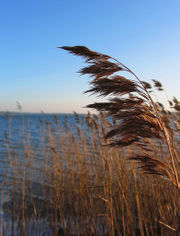
- PolygonaceaePolygonaceaePolygonaceae is a family of flowering plants known informally as the "knotweed family" or "smartweed family"— "buckwheat family" in the United States. The name is based on the genus Polygonum and was first used by Antoine Laurent de Jussieu in 1789 in his book, Genera Plantarum. The name refers...
- Erigonum sp.: DMT
- Punicaceae
- Punica granatum "DMT in root cortex;" The dried stem and root bark of the tree contain about 0.4-0.9% alkaloids.
- RubiaceaeRubiaceaeThe Rubiaceae is a family of flowering plants, variously called the coffee family, madder family, or bedstraw family. The group contains many commonly known plants, including the economically important coffee , quinine , and gambier , and the horticulturally valuable madder , west indian jasmine ,...
Psychotria carthagenensisPsychotria carthagenensisPsychotria carthagenensis, also known as Amyruca, is a South American rainforest understory shrub from the coffee family, Rubiaceae...
, 0.2% average DMT in dried leaves
- Psychotria expansaPsychotria expansaPsychotria expansa is a West Sumatran rainforest understory shrub from the coffee family, Rubiaceae....
, DMT
- Psychotria forsterianaPsychotria forsterianaPsychotria forsteriana is a South American rainforest understory shrub from the coffee family, Rubiaceae....
, DMT
- Psychotria insularumPsychotria insularumPsychotria insularum is a South American rainforest understory shrub from the coffee family, Rubiaceae....
, DMT
- Psychotria poeppigianaPsychotria poeppigianaPsychotria poeppigiana is a plant species in the family Rubiaceae; a common name is Sore-mouth Bush, though it is not very often used....
http://www.discoverlife.org/mp/20q?search=Psychotria+poeppigiana, DMT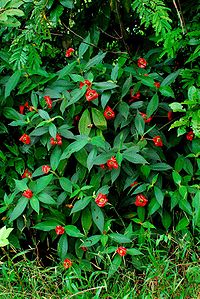
- Psychotria rostrataPsychotria rostrataPsychotria rostrata is a South American rainforest understory shrub from the coffee family, Rubiaceae....
, DMT
- Psychotria rufipilisPsychotria rufipilisPsychotria rufipilis is an African rainforest understory shrub from the coffee family, Rubiaceae....
, DMT
- Psychotria viridisPsychotria viridisPsychotria viridis is a shrub from the coffee family, Rubiaceae. It has many local names, including Chacruna and Chacrona ....
, DMT 0.1-0.61% dried mass.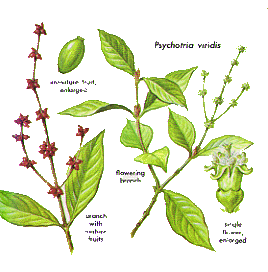
- RutaceaeRutaceaeRutaceae, commonly known as the rue or citrus family, is a family of flowering plants, usually placed in the order Sapindales.Species of the family generally have flowers that divide into four or five parts, usually with strong scents...
Dictyoloma incanescens, 5-MeO-DMT in leaves, 0.04% 5-MeO-DMT in bark
- Dutaillyea drupacea, > 0.4 % 5-MeO-DMT in leaves
- Dutaillyea oreophila, 5-MeO-DMT in leaves
- Tetradium ruticarpum(syn. Evodia rutaecarpa), 5-MeO-DMT in leaves, fruit and roots
- Limonia acidissima, 5-MeO-DMT in stems
_in_talakona_forest,_ap_w_img_8334.jpg)
- Euodia leptococca (formerly Melicope), 0.2% total alkaloids, 0.07% 5-MeO-DMT; 5-MeO-DMT in leaves and stems, also "5-MeO-DMT-Oxide and a beta-carboline"
- Pilocarpus organensis, 5-MeO-DMT in leaves
- Vepris ampody, Up to 0.2% DMT in leaves and branches
- Zanthoxylum arborescens, DMT in leaves
- Zanthoxylum procerumZanthoxylum procerumZanthoxylum procerum is a species of plant in the Rutaceae family. It is found in Belize, Costa Rica, Guatemala, Honduras, Mexico, Nicaragua, and Panama.-References:* Nelson, C. 1998. . Downloaded on 24 August 2007....
, DMT in leaves
- UrticaceaeUrticaceaeUrticaceae, or the nettle family, is a family of flowering plants. The family name comes from the genus Urtica . Urticaceae includes a number of well-known and useful plants, including the aforementioned nettles, Ramie , māmaki , and ajlai .The family includes approximately 2600 species, grouped...
- Urtica pilulifera: Bufotenin
- Echinopsis lageniformis
 Echinopsis lageniformisBolivian Torch cactus is a fast-growing columnar cactus from the high deserts of Bolivia....
Echinopsis lageniformisBolivian Torch cactus is a fast-growing columnar cactus from the high deserts of Bolivia....
(syn. Trichocereus bridgesii) , MescalineMescalineMescaline or 3,4,5-trimethoxyphenethylamine is a naturally occurring psychedelic alkaloid of the phenethylamine class used mainly as an entheogen....
> 0.025%, also 3,4-dimethoxyphenylethylamine < 1%, 3-methoxytyramine < 1%, tyramine < 1% - Mescaline 2%
- Echinopsis scopulicola (syn. Trichocereus scopulicola) , Mescaline

- Echinopsis pachanoiEchinopsis pachanoiThe San Pedro cactus is a fast-growing columnar cactus native to the Andes Mountains of Peru between 2000–3000 m in altitude. It is also found in Argentina, Bolivia, Chile and Ecuador, and it is cultivated in other parts of the world...
(syn. Trichocereus pachanoi), Mescaline 0.006-0.12%, 0.05% Average - Mescaline 0.01%-2.375%
- Echinopsis spachianaEchinopsis spachianaEchinopsis spachiana is a species of cactus native to South America. Commonly cultivated as a pot- or rockery plant around the world, it has a lime green body with 1-2 cm long golden spines. It exhibits a columnar habit....
(syn. Trichocereus spachianus), Mescaline - Mescaline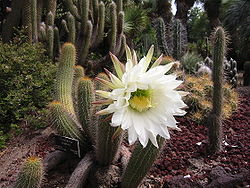
- Lophophora williamsii (Peyote), 0.4% Mescaline - 3-6% Mescaline
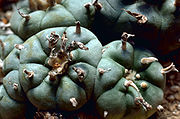
- Opuntia acanthocarpa Mescaline

- Opuntia basilarisOpuntia basilarisOpuntia basilaris, the Beavertail Cactus, is found in southwest USA, mostly in the Mojave Desert, Anza-Borrego Desert State Park, and Colorado Deserts, and also in the Colorado Plateau and northwest Mexico; it ranges through the Grand Canyon and Colorado River region to southern Utah, and in...
Mescaline 0.01%, plus 4-hydroxy-3-5-dimethoxyphenethylamine
- Austrocylindropuntia cylindrica (syn. Opuntia cylindrica), Mescaline
- Cylindropuntia echinocarpaCylindropuntia echinocarpaCylindropuntia echinocarpa is a species of cactus known by the common names Silver cholla, Golden cholla, and Wiggins' cholla.-Distribution:...
(syn. Opuntia echinocarpa), Mescaline 0.01%, 3-4-dimethoxyphenethylamine 0.01%, 4-hydroxy-3-5-dimethoxyphenethylamine 0.01%
- Cylindropuntia spinosior (syn. Opuntia spinosior), Mescaline 0.00004%, 3-methoxytyramine 0.001%, tyramine 0.002%, 3-4-dimethoxyphenethylamine.
- Echinopsis macrogonaEchinopsis macrogonaEchinopsis macrogona or Trichocereus macrogonus There are 60 known species of Trichocereus, many of which contain psychoactive alkaloids such as mescaline. Trichocereus Macrogonus, a close cousin to the San Pedro, Peruvian Torch and Trichocereus bridgesii, is a blue-green Trichocereus. They are...
(syn. Trichocereus macrogonus), > 0.01-0.05% Mescaline
- Echinopsis peruviana (syn. Trichocereus peruvianus), Mescaline 0.0005%-0.12% - Mescaline
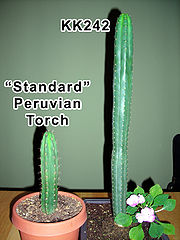
- Echinopsis tacaquirensis subsp. taquimbalensis (syn. Trichocereus taquimbalensis), > 0.005-0.025% Mescaline
- Echinopsis terscheckii (syn. Trichocereus terscheckii, Trichocereus werdemannianus) > 0.005-0.025% Mescaline - Mescaline 0.01%-2.375%
- Echinopsis valida , 0.025% Mescaline
- Pelecyphora aselliformis, Mescaline
- ApocynaceaeApocynaceaeThe Apocynaceae or dogbane family is a family of flowering plants that includes trees, shrubs, herbs, and lianas.Many species are tall trees found in tropical rainforests, and most are from the tropics and subtropics, but some grow in tropical dry, xeric environments. There are also perennial herbs...
- Amsonia tabernaemontana, Harmine
- Aspidosperma exalatum, Beta-carbolines
- Aspidosperma polyneuronAspidosperma polyneuronAspidosperma polyneuron is a timber tree native to Brazil, Colombia, Peru, Argentina, and Paraguay which is typical of Atlantic Forest vegetation...
, Beta-carbolines
- Apocynum cannabinumApocynum cannabinumApocynum cannabinum is a perennial herbaceous plant that grows throughout much of North America - in the southern half of Canada and throughout the United States. It is a poisonous plant: Apocynum means "poisonous to dogs"...
, Harmalol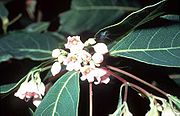
- Ochrosia nakaiana, Harman
- Pleicarpa mutica, Beta-carbolines
- Amsonia tabernaemontana, Harmine
- BignoniaceaeBignoniaceaeThe Bignoniaceae, or Trumpet Creeper Family, is a family of flowering plants comprising about 650-750 species in 116-120 genera. Members of the family are mostly trees and lianas , shrubs and more rarely herbaceous plants. As climber plants, they are twine climbers or tendril climbers, and rarely...
- Newbouldia laevis, Harman
- Newbouldia laevis, Harman
- CalycanthaceaeCalycanthaceaeThe Calycanthaceae is a small family of flowering plants included in the order Laurales. The family contains four genera and only 6-11 species, restricted to warm temperate and tropical regions:...
- Calycanthus occidentalis, HarmineHarmineHarmine is a fluorescent harmala alkaloid belonging to the beta-carboline family of compounds. It occurs in a number of different plants, most notably the Middle Eastern plant harmal or Syrian rue and the South American vine Banisteriopsis caapi...
- Calycanthus occidentalis, Harmine
- ChenopodiaceaeChenopodiaceaeChenopodiaceae were a family of flowering plants, also called the Goosefoot Family. They are now included within family Amaranthaceae. The vast majority of Chenopods are weeds, and many are salt and drought tolerant. A few food crops also belong to the family: spinach, beets, chard, quinoa, and...
- Hammada leptoclada, Tetrahydroharman, etc.
- Kochia scopariaKochia scopariaBassia scoparia is a shrub which is native to Eurasia. It has introduced populations in many parts of North America, where it is found in grassland, prairie, and desert shrub ecosystems...
, Harmine, etc.
- Hammada leptoclada, Tetrahydroharman, etc.
- CombretaceaeCombretaceaeCombretaceae is a family of flowering plants in the order Myrtales. The family includes about 600 species of trees, shrubs, and lianas in 18 genera. The family includes the leadwood tree, Combretum imberbe. Three genera, Conocarpus, Laguncularia and Lumnitzera, grow in mangrove habitats ....
- Guiera senegalensisGuiera senegalensisGuiera senegalensis is a flowering plant species in the genus Guiera. The plant produces the tannin 3,4,5-Tri-O-galloylquinic acid and several alkaloids of the harman family....
, Harman, etc.
- Guiera senegalensis
- CyperaceaeCyperaceaeCyperaceae are a family of monocotyledonous graminoid flowering plants known as sedges, which superficially resemble grasses or rushes. The family is large, with some 5,500 species described in about 109 genera. These species are widely distributed, with the centers of diversity for the group...
- Carex brevicollis, Harmine, etc.
- Carex parva, Beta-carbolines
- Carex brevicollis, Harmine, etc.
- ElaeagnaceaeElaeagnaceaeElaeagnaceae, the oleaster family, is a plant family of the order Rosales comprising small trees and shrubs, native to temperate regions of the Northern Hemisphere, south into tropical Asia and Australia. The family has 45-50 species in three genera....
- Elaeagnus angustifoliaElaeagnus angustifoliaElaeagnus angustifolia, commonly called silver berry, oleaster, Russian olive, or wild olive, is a species of Elaeagnus, native to western and central Asia, from southern Russia and Kazakhstan to Turkey and Iran...
, Harman, etc.
- Elaeagnus commutataElaeagnus commutataElaeagnus commutata , is a species of Elaeagnus native to western and boreal North America, from southern Alaska through British Columbia east to Quebec, south to Utah, and across the upper Midwestern United States to South Dakota and western Minnesota...
, Beta-carbolines
- Elaeagnus hortensis, Tetrahydroharman, etc.
- Elaeagnus orientalis, Tetrahydroharman
- Elaeagnus spinosa, Tetrahydroharman
- Hippophae rhamnoidesHippophae rhamnoidesHippophae rhamnoides, the common sea-buckthorn, is a deciduous shrub species in the genus Hippophae.Common Sea-buckthorn branches are dense, stiff, and very thorny. The leaves are a distinct pale silvery-green, lanceolate, 3-8 cm long and less than 7 mm broad. It is dioecious, with male and female...
, Harman, etc.
- Shepherdia argenteaShepherdia argenteaShepherdia argentea is a species of Shepherdia, native to central North America from southern Canada south in the United States to northern California and New Mexico.It is a deciduous shrub growing to 2–6 m tall...
, Tetrahydroharmol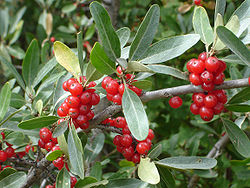
- Shepherdia canadensis, Tetrahydroharmol

- Elaeagnus angustifolia
- Gramineae
- Arundo donaxArundo donaxArundo donax, Giant Cane, is a tall perennial cane growing in damp soils, either fresh or moderately saline. Other common names include Carrizo, Arundo, Spanish cane, Wild cane, and Giant reed....
, Tetrahydroharman
- Festuca arundinaceaFestuca arundinaceaFestuca arundinacea is a species of fescue commonly known as Tall fescue. It is a cool-season perennial C3 species of bunchgrass native to Europe. It is an important forage grass throughout Europe, and many cultivars have been used in agriculture...
, Harman, etc.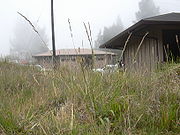
- Lolium perenneLolium perenneLolium perenne, common name Perennial Ryegrass, is a grass from the family Poaceae. It is native to Europe, Asia and northern Africa, but is widely cultivated and naturalised around the world.-Description:...
, (Perennial Ryegrass), Harman, etc.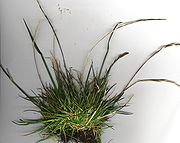
- Phalaris aquaticaPhalaris aquaticaPhalaris aquatica, syn. P. tuberosa, known by the common names Bulbous canarygrass and Harding grass, is a species of grass in the genus Phalaris of the Poaceae Family.-Description:...
, Beta-carbolines
- Phalaris arundinacea, Beta-carbolines
- Arundo donax
- LauraceaeLauraceaeThe Lauraceae or Laurel family comprises a group of flowering plants included in the order Laurales. The family contains about 55 genera and over 3500, perhaps as many as 4000, species world-wide, mostly from warm or tropical regions, especially Southeast Asia and South America...
- Nectandra megapotamica, Beta-carbolines
- Nectandra megapotamica, Beta-carbolines
- Leguminosae
- Acacia baileyana, Tetrahydroharman
- Acacia complanataAcacia complanataAcacia complanata, generally known as Long-pod Wattle and Flat-stemmed Wattle, is a perennial tree native to Australia. It can grow 5–6 m tall, but more often it grows as a large shrub. It is not listed as being a threatened species...
, Tetrahydroharman, etc.
- Burkea africanaBurkea africanaBurkea africana Hook. f. is a deciduous, medium-sized, spreading, flat-topped tree belonging to the family Caesalpiniaceae.Widespread in tropical Africa, it is found in Chad, Sudan, Tanzania, Uganda, Cameroon, Central African Republic, Zaire, Benin, Burkina Faso, Côte d'Ivoire, Ghana, Guinea, Mali,...
, Harman, etc.
- Desmodium gangeticumDesmodium gangeticumDesmodium gangeticum is plant in the Fabaceae family....
, Beta-carbolines
- Desmodium gyrans, Beta-carbolines
- Desmodium pulchellum, Harman, etc.
- Mucuna pruriensMucuna pruriensMucuna pruriens is a tropical legume known as velvet bean or cowitch and by other common names , found in Africa, India and the Caribbean. The plant is infamous for its extreme itchiness produced on contact, particularly with the young foliage and the seed pods...
, 6-Methoxy-Harman
- Petalostylis labicheoides, Tetrahydroharman; MAO's up to 0.5%
- Prosopis nigraProsopis nigraProsopis nigra is a South American leguminous tree species that inhabits the Gran Chaco ecoregion , in Argentina and Paraguay...
, Harman, etc.
- Shepherdia pulchellum, Beta-carbolines
- Acacia baileyana, Tetrahydroharman
- LoganiaceaeLoganiaceaeLoganiaceae are a family of flowering plants classified in order Gentianales. The family includes 13 genera, distributed around the world's tropics.Earlier treatments of the family have included up to 29 genera...
- Strychnos melinoniana, Beta-carbolines
- Strychnos usambarensis, Harman
- Strychnos melinoniana, Beta-carbolines
- MalpighiaceaeMalpighiaceaeMalpighiaceae is a family of flowering plants in the order Malpighiales. It comprises approximately 75 genera and 1300 species, all of which are native to the tropics and subtropics...
- Banisteriopsis argentia, 5-methoxytetrahydroharman, (-)-N(6)-methoxytetrahydroharman, dimethyltryptamine-N(6)-oxide
- Banisteriopsis caapiBanisteriopsis caapiBanisteriopsis caapi, also known as Ayahuasca, Caapi or Yage, is a South American jungle vine of the family Malpighiaceae. It is used to prepare Ayahuasca, a decoction that has a long history of entheogenic uses as a medicine and "plant teacher" among the indigenous peoples of the Amazon Rainforest...
, HarmineHarmineHarmine is a fluorescent harmala alkaloid belonging to the beta-carboline family of compounds. It occurs in a number of different plants, most notably the Middle Eastern plant harmal or Syrian rue and the South American vine Banisteriopsis caapi...
0.31-0.84%, tetrahydroharmine, telepathine, dihydroshihunine, 5-MeO-DMT in bark
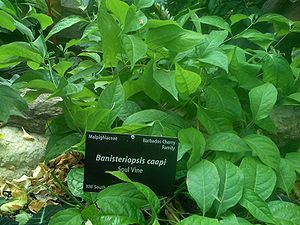
- Banisteriopsis inebrians, Beta-carbolines
- Banisteriopsis lutea, Harmine, telepathine
- Banisteriopsis metallicolor, Harmine, telepathine
- Banisteriopsis muricata, Harmine up to 6%, harmaline up to 4%, plus DMT
- Diplopterys cabreranaDiplopterys cabreranaDiplopterys cabrerana is a South American rainforest vine, commonly known as Chaliponga, Chagropanga and, in parts of Ecuador, Chacruna...
, Beta-carbolines
- Cabi pratensis, Beta-carbolines
- Callaeum antifebrile(syn. Cabi paraensis), Harmine
- Banisteriopsis argentia, 5-methoxytetrahydroharman, (-)-N(6)-methoxytetrahydroharman, dimethyltryptamine-N(6)-oxide
- MyristicaceaeMyristicaceaeMyristicaceae is the botanical name for a family of flowering plants. The family has been recognised by most taxonomists; it is sometimes called the "nutmeg family", after its most famous member, Nutmeg ....
- Gymnacranthera paniculata, Beta-carbolines
- Horsfieldia superbaHorsfieldia superbaHorsfieldia superba is a species of plant in the Myristicaceae family. It is found in Indonesia, Malaysia, and Singapore, and is threatened by habitat loss...
Beta-carbolines
- Virola cuspidataVirola cuspidataVirola cuspidata is a species of tree in the Myristicaceae family....
, 6-Methoxy-Harman
- Virola rufulaVirola rufulaVirola rufula is a species of tree in the Myristicaceae family.The tree contains alkaloids in its bark, leaves and roots. 5-methoxy-dimethyltryptamine makes up 95% of the alkaloids. There is about 0.190% 5-MeO-DMT in bark, 0.135% 5-MeO-DMT in root, and 0.092% dimethyltryptamine in the leaves....
, Beta-carbolines
- Virola theiodora, Beta-carbolines
- Gymnacranthera paniculata, Beta-carbolines
- OchnaceaeOchnaceaeThe family Ochnaceae, or wild plane family, comprises mainly trees or shrubs, and more rarely herbaceous plants. Species of the Ochnaceae are found from subtropical to tropical regions. They are best represented in South America...
- Testulea gabonensisTestulea gabonensisTestulea gabonensis is a species of plant in the Ochnaceae family. It is found in Cameroon, the Republic of the Congo, Equatorial Guinea, and Gabon. It is threatened by habitat loss.-References:...
, Beta-carbolines
- Testulea gabonensis
- Palmae
- Plectocomiopsis geminiflora, Beta-carbolines
- Plectocomiopsis geminiflora, Beta-carbolines
- PapaveraceaePapaveraceaePapaveraceae, informally known as the poppy family, are an economically important family of 44 genera and approximately 770 species of flowering plants in the order Ranunculales. The family is cosmopolitan, occurring in temperate and subtropical climates, but almost unknown in the tropics...
- Meconopsis horridula, Beta-carbolines
- Meconopsis napaulensis, Beta-carbolines

- Meconopsis paniculata, Beta-carbolines
- Meconopsis robusta, Beta-carbolines
- Meconopsis rudis, Beta-carbolines
- Papaver rhoeas, Beta-carbolines

- Meconopsis horridula, Beta-carbolines
- PassifloraceaePassifloraceaePassifloraceae is a family of flowering plants, containing about 530 species classified in around 18 genera. They include trees, shrubs, lianas and climbing plants, and are mostly found in tropical regions....
:
- Passiflora actiniaPassiflora actiniaPassiflora actinia species of passion flower of the Passifloraceae. It flowers mainly in early spring.P. actinia is an evergreen vine. Its fruit is edible....
, Harman
- Passiflora alataPassiflora alataPassiflora alata, the winged-stem passion flower, is a vine which bears an edible type of passion fruit. It is native to the Amazon region of Brazil. The native peoples living in areas where the plant thrives refer to it as "ouvaca," meaning "red star" due to the appearance of its flower...
, Harman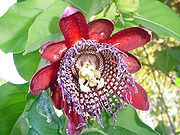
- Passiflora alba, Harman
- Passiflora bryonoides, Harman
- Passiflora caeruleaPassiflora caeruleaPassiflora caerulea, commonly known as the Blue Passion Flower or the Common Passion Flower, is a vine native to South America...
, Harman
- Passiflora capsularisPassiflora capsularisPassiflora capsularis is a species in the Passifloraceae family....
, Harman
- Passiflora decaisneana, Harman
- Passiflora edulisPassiflora edulisPassiflora edulis is a vine species of passion flower that is native to Paraguay, Brazil and northern Argentina . Its common names include passion fruit and passionfruit...
, Harman, 0-7001 ppm in fruit
- Passiflora eichleriana, Harman
- Passiflora foetidaPassiflora foetidaPassiflora foetida is a species of passion flower that is native to the southwestern United States , Mexico, the Caribbean, Central America, and much of South America...
, Harman
- Passiflora incarnataPassiflora incarnataPassiflora incarnata, commonly known as maypop, purple passionflower, true passionflower, wild apricot, and wild passion vine, is a fast growing perennial vine with climbing or trailing stems. A member of the passionflower genus Passiflora, the maypop has large, intricate flowers with prominent...
(with bee), Harmine, Harmaline, Harman, etc. 0.03%. Alkaloids in rind of fruit 0.25%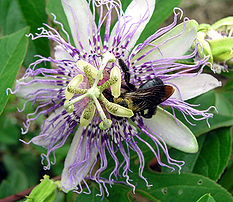
- Passiflora quadrangularis, Harman

- Passiflora ruberosa, Harman
- Passiflora subpeltataPassiflora subpeltataPassiflora subpeltata, commonly known as White passion flower, is a passion flower bearing edible yellow-green fruits that are very sweet. It is a vining plant with three-lobed leaves and 2-3 ornate flowers. It is grown as an ornamental plant. This vine is also a marginal pest in areas....
, Harman
- Passiflora warmingii, Harman
- Passiflora actinia
- PolygonaceaePolygonaceaePolygonaceae is a family of flowering plants known informally as the "knotweed family" or "smartweed family"— "buckwheat family" in the United States. The name is based on the genus Polygonum and was first used by Antoine Laurent de Jussieu in 1789 in his book, Genera Plantarum. The name refers...
- Calligonum minimum, Beta-carbolines
- Leptactinia densifloraLeptactinia densifloraLeptactina densiflora, also known as Leptactinia, is a stove shrub from central Africa, and can grow from 6 to 12 feet. The plant is a psychedelic, containing tetrahydroharmine which is a monoamine oxidase inhibitor....
, Leptaflorine, etc.
- Ophiorrhiza japonica, Harman
- Pauridiantha callicarpoides, Harman
- Pauridiantha dewevrei, Harman
- Pauridiantha lyalli, Harman
- Pauridiantha viridiflora, Harman
- Simira klugei, Harman
- Simira rubra, Harman
- Calligonum minimum, Beta-carbolines
- RubiaceaeRubiaceaeThe Rubiaceae is a family of flowering plants, variously called the coffee family, madder family, or bedstraw family. The group contains many commonly known plants, including the economically important coffee , quinine , and gambier , and the horticulturally valuable madder , west indian jasmine ,...
- Borreria verticillata, Beta-carbolines
- Leptactinia densifloraLeptactinia densifloraLeptactina densiflora, also known as Leptactinia, is a stove shrub from central Africa, and can grow from 6 to 12 feet. The plant is a psychedelic, containing tetrahydroharmine which is a monoamine oxidase inhibitor....
, Beta-carbolines
- Nauclea diderrichiiNauclea diderrichiiNauclea diderrichii is a species of plant in the Rubiaceae family. It is found in Angola, Cameroon, Central African Republic, the Republic of the Congo, the Democratic Republic of the Congo, Ivory Coast, Gabon, Ghana, Liberia, Mozambique, Nigeria, Sierra Leone, and Uganda. Its natural habitat is...
, Beta-carbolines
- Ophiorrhiza japonica, Beta-carbolines
- Pauridiantha callicarpoides, Beta-carbolines
- Pauridiantha dewevrei, Beta-carbolines
- Pauridiantha yalli, Beta-carbolines
- Pauridiantha viridiflora, Beta-carbolines
- Pavetta lanceolata, Beta-carbolines
- Psychotria carthagenensisPsychotria carthagenensisPsychotria carthagenensis, also known as Amyruca, is a South American rainforest understory shrub from the coffee family, Rubiaceae...
, Beta-carbolines
- Psychotria viridisPsychotria viridisPsychotria viridis is a shrub from the coffee family, Rubiaceae. It has many local names, including Chacruna and Chacrona ....
, Beta-carbolines
- Simira klugei, Beta-carbolines
- Simira rubra, Beta-carbolines
- Uncaria attenuata, Beta-carbolines
- Uncaria canescens, Beta-carbolines
- Uncaria orientalis, Beta-carbolines
- Borreria verticillata, Beta-carbolines
- RutaceaeRutaceaeRutaceae, commonly known as the rue or citrus family, is a family of flowering plants, usually placed in the order Sapindales.Species of the family generally have flowers that divide into four or five parts, usually with strong scents...
- TetradiumTetradiumTetradium is a genus of nine species of trees in the family Rutaceae, occurring in temperate to tropical east Asia. In older books, the genus was often included in the related genus Euodia , but that genus is now restricted to tropical species...
(syn. Evodia) species: Some contain carbolines
- Euodia leptococca Beta-carboline
- Araliopsis tabouensis, Beta-carbolines
- Flindersia laevicarpaFlindersia laevicarpaFlindersia laevicarpa is a species of plant in the Rutaceae family. It is found in Australia, West Papua , and Papua New Guinea. It is threatened by habitat loss.-Source:* Eddowes, P.J. 1998. . Downloaded on 21 August 2007....
, Beta-carbolines
- Xanthoxylum rhetsa, Beta-carbolines
- Tetradium
- SapotaceaeSapotaceaeSapotaceae is a family of flowering plants, belonging to order Ericales. The family includes approximately 800 species of evergreen trees and shrubs in approximately 65 genera . Distribution is pantropical....
- Chrysophyllum lacourtianum, Norharman etc.
- Chrysophyllum lacourtianum, Norharman etc.
- SimaroubaceaeSimaroubaceaeThe Simaroubaceae is a small, mostly tropical, family in the order Sapindales. In recent decades it has been subject to much taxonomic debate, with several small families being split off...
- Ailanthus malabarica, Beta-carbolines. See also Nag ChampaNag ChampaNag Champa is an Indian fragrance, commonly found in incense, soap, perfume oil, essential oils, candles and personal toileteries originating there. It is commonly used in ashrams.-Composition and properties:...
.
- Perriera madagascariensis, Beta-carbolines
- Picrasma ailanthoides, Beta-carbolines
- Picrasma crenataPicrasma crenataPicrasma crenata, the pau-amargo, pau-tenente or tenente-josé, is a tree species that belongs to the family Simaroubaceae. It occurs in Brazil , in the regions Nordeste , Sudeste and Sul...
, Beta-carbolines
- Picrasma excelsaPicrasma excelsaPicrasma excelsa is a species of Picrasma in the family Simaroubaceae. It is found in Cuba, the Dominican Republic, Haiti, Jamaica, Puerto Rico, Saint Vincent and the Grenadines, and Venezuela. It is threatened by habitat loss.-References:...
, Beta-carbolines
- Picrasma javanica, Beta-carbolines
- Ailanthus malabarica, Beta-carbolines. See also Nag Champa
- SolanaceaeSolanaceaeSolanaceae are a family of flowering plants that include a number of important agricultural crops as well as many toxic plants. The name of the family comes from the Latin Solanum "the nightshade plant", but the further etymology of that word is unclear...
- Vestia foetida, (Syn V. lycioides) Beta-carbolines
- Vestia foetida, (Syn V. lycioides) Beta-carbolines
- SymplocaceaeSymplocaceaeSymplocos is a genus of flowering plants in the order Ericales, containing about 250 species native to Asia, Australia and the Americas.Symplocos species are used as food plants by the larvae of some Lepidoptera species including The Engrailed....
- Symplocos racemosa, Harman
- Symplocos racemosa, Harman
- TiliaceaeTiliaceaeTiliaceae is a botanical name for a family of flowering plants. Such a family is not part of APG II, but it is found all through the botanical literature and remains prominently listed by nomenclatural databases such as IPNI....
- Grewia mollis, Beta-carbolines
- Grewia mollis, Beta-carbolines
- ZygophyllaceaeZygophyllaceaeThe Zygophyllaceae is a family of flowering plants that contains the bean-caper and caltrop. It includes around 285 species in 22 genera.In the APG III system of classification, the families Zygophyllaceae and Krameriaceae compose the order Zygophyllales...
- Fagonia creticaFagonia creticaFagonia cretica is a species of plant in the Zygophyllaceae, the Caltrop family, specifically the fagonbushes. It is found in Alicante Province, Spain and the Balearic Islands....
, Harman
- Nitraria schoberi, Beta-carbolines
- Peganum harmala, (Syrian Rue), The seeds contain about 2-6% alkaloids, most of which is harmalineHarmalineHarmaline is a fluorescent psychoactive indole alkaloid from the group of harmala alkaloids and beta-carbolines. It is the reduced hydrogenated form of harmine.-Occurrence in nature:...
. Peganum harmala is also an abortifacientAbortifacientAn abortifacient is a substance that induces abortion. Abortifacients for animals that have mated undesirably are known as mismating shots....
.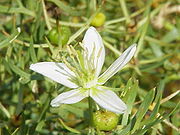
- Peganum nigellastrum, Harmine
- Tribulus terrestrisTribulus terrestrisTribulus terrestris is a flowering plant in the family Zygophyllaceae, native to warm temperate and tropical regions of the Old World in southern Europe, southern Asia, throughout Africa, and Australia. It can thrive even in desert climates and poor soil...
, Harman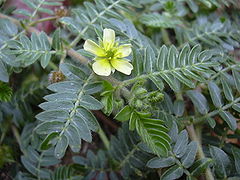
- Zygophyllum fabagoZygophyllum fabagoZygophyllum fabago is a species of plant known by the common name Syrian bean-caper. It is considered a noxious weed of economic importance in many of the western United States. It is native to Asia and the Middle East.-Growth:...
, Harman, harmine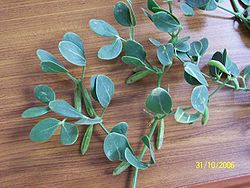
Plants containing other psychedelic substances
Acoraceae:- Acorus calamus, asaroneAsaroneAsarone, which includes alpha and beta types, is an ether found in certain plants such as acorus and asarum. As a volatile fragrance oil, it is used in killing plant fungal pests and bacteria...
Salvinorin A Salvinorin ASalvinorin A is the main active psychotropic molecule in Salvia divinorum, a Mexican plant which has a long history of use as an entheogen by indigenous Mazatec shamans...
Salvia divinorumSalvia divinorumSalvia divinorum is a psychoactive plant which can induce dissociative effects and is a potent producer of "visions" and other hallucinatory experiences...Salvinorin A, 0.89-3.87 mg/g, also Salvinorin B and Salvinorin C
Cathinone CathinoneCathinone, or Benzoylethanamine, is a monoamine alkaloid found in the shrub Catha edulis and is chemically similar to ephedrine, cathine and other amphetamines. Cathinone induces the release of dopamine from striatal preparations that are prelabelled either with dopamine or its precursors. It is...
Catha edulisKhat KhatKhat, qat, gat or Waquish Spoken from true Yemeni, is a flowering plant native to tropical East Africa and the Arabian Peninsula....
Unknown 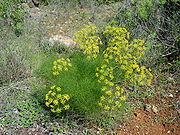
Foeniculum vulgareUnknown 
Unknown 
Justicia pectoralisJusticia pectoralisJusticia pectoralis is a herb of the Acanthus family . This water-willow is widely known as tilo in Latin America. In Haiti it is called chapantye and zeb chapantyè on Dominica and Martinique...Unknown
Pukateine PukateinePukateine is an alkaloid found in the bark of the New Zealand tree Laurelia novae-zelandiae . An extract from pukatea is used in traditional Māori herbal medicine as an analgesic, and it is thought pukateine is the active component, as it is similar in both structure and activity to alkaloids such...
Laurelia novae-zelandiaeLaurelia novae-zelandiaeLaurelia novae-zelandiae, also called Pukatea, is a large laurifolia evergreen tree, endemic to the forests of New Zealand . with so-called 'toothed' leaves and producing small flowers...Pukateine PukateinePukateine is an alkaloid found in the bark of the New Zealand tree Laurelia novae-zelandiae . An extract from pukatea is used in traditional Māori herbal medicine as an analgesic, and it is thought pukateine is the active component, as it is similar in both structure and activity to alkaloids such...
Thujone ThujoneThujone is a ketone and a monoterpene that occurs naturally in two diastereomeric forms: -α-thujone and -β-thujone. It has a menthol odor. Even though it is best known as a chemical compound in the spirit absinthe, recent tests show absinthe contains only small quantities of thujone, and may or may...
Artemisia vulgarisArtemisia vulgarisArtemisia vulgaris is one of several species in the genus Artemisia which have common names that include the word mugwort. This species is also occasionally known as Felon Herb, Chrysanthemum Weed, Wild Wormwood, Old uncle Henry, Sailor's Tobacco, Naughty Man, Old Man or St...Thujone ThujoneThujone is a ketone and a monoterpene that occurs naturally in two diastereomeric forms: -α-thujone and -β-thujone. It has a menthol odor. Even though it is best known as a chemical compound in the spirit absinthe, recent tests show absinthe contains only small quantities of thujone, and may or may...
Damianin 
Turnera diffusaDamianin 
unknown 
Magnolia virginianaThe leaves or bark have been placed in cupped hands over the nose and inhaled as a mild hallucinogen
Bulbocapnine BulbocapnineBulbocapnine is an alkaloid found in Corydalis and Dicentra, herbs in the family Fumariaceae that can cause fatal poisoning in sheep and cattle...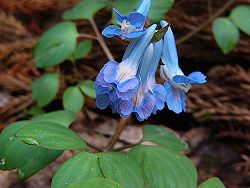
Corydalis solidaCorydalis solidaCorydalis solida is a spring ephemeral plant valued for its purple, red, or white flowers, native or introduced to central and eastern Europe.Height is 10-20 cm . Root is a tuber.-External links:* at Virtuella floran...
, Corydalis cavaBulbocapnine BulbocapnineBulbocapnine is an alkaloid found in Corydalis and Dicentra, herbs in the family Fumariaceae that can cause fatal poisoning in sheep and cattle...
, NantenineNantenineNantenine is an alkaloid found in the plant Nandina domestica as well as some Corydalis species. It is an antagonist at both the α1 adrenergic receptor and the 5-HT2A serotonin receptor, and blocks both the behavioural and physiological effects of MDMA in animals.-See...
, TetrahydropalmatineTetrahydropalmatineTetrahydropalmatine is an alkaloid found in several different plant species, mainly in the Corydalis family, but also in other plants such as Stephania rotunda. These plants have traditional uses in Chinese herbal medicine...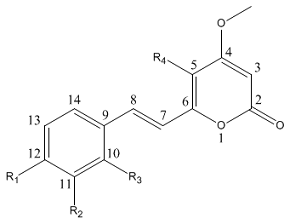
Kavalactones 
Piper methysticumKavalactones
Lagochilin 
Lagochilus inebriansLagochilin is thought to be responsible for the sedative, hypotensive and hemostatic effects of this plant. 
Unknown
Tagetes lucidaTagetes lucidaTagetes lucida is a half-hardy sub-shrub native to Mexico and Central America. It is eaten as an herb and is commonly used as a substitute for tarragon. The leaves have a tarragon-like flavor, with hints of anise...Anethole AnetholeAnethole is a phenylpropene, a type of aromatic compound that occurs widely in nature, in essential oils...
, ChavicolChavicolChavicol, or p-allylphenol, is a natural phenylpropene, a type of organic compound. Its chemical structure consists of a benzene ring substituted with a hydroxy group and a propenyl group. It is a colorless liquid found together with terpenes in betel oil. It is miscible with alcohol, ether, and...
, CoumarinCoumarinCoumarin is a fragrant chemical compound in the benzopyrone chemical class, found in many plants, notably in high concentration in the tonka bean , vanilla grass , sweet woodruff , mullein , sweet grass , cassia cinnamon and sweet clover...
, EstragoleEstragoleEstragole is a phenylpropene, a natural organic compound. Its chemical structure consists of a benzene ring substituted with a methoxy group and a propenyl group. Estragole is a double-bond isomer of anethole. It is a colorless to pale yellow liquid...
, IsorhamnetinIsorhamnetinIsorhamnetin is an O-methylated flavonol, a type of chemical compound. It can be found in Tagetes lucida, a psychedelic plant from Mexico and Central America.-Metabolism:...
, Methyleugenol, Quercitin
Lactucarium LactucariumLactucarium is the milky fluid secreted by several species of lettuce, especially Lactuca virosa, usually from the base of the stems. Lactucarium is known as lettuce opium because of its sedative and analgesic properties...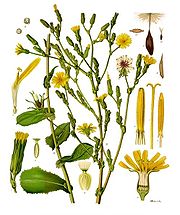
Lactuca virosaLactuca virosaLactuca virosa is a plant in the Lactuca genus, ingested often for its mild psychotropic effects which are often described as being similar to that of opium. It is related to common lettuce Lactuca virosa is a plant in the Lactuca (lettuce) genus, ingested often for its mild psychotropic...Lactucarium LactucariumLactucarium is the milky fluid secreted by several species of lettuce, especially Lactuca virosa, usually from the base of the stems. Lactucarium is known as lettuce opium because of its sedative and analgesic properties...
Glaucine GlaucineGlaucine is an alkaloid found in several different plant species such as Glaucium flavum, Glaucium oxylobum, Croton lechleri and Corydalis yanhusuo. It has bronchodilator and antiinflammatory effects, acting as a PDE4 inhibitor and calcium channel blocker, and is used medically as an antitussive in...
Glaucium flavumGlaucium flavumGlaucium flavum is a summer flowering plant in the Papaveraceae family, which is native to Northern Africa, Macaronesia, temperate zones in Western Asia and the Caucasus, as well as Europe. Habitat: the plant grows on the seashore and is never found inland...Glaucine GlaucineGlaucine is an alkaloid found in several different plant species such as Glaucium flavum, Glaucium oxylobum, Croton lechleri and Corydalis yanhusuo. It has bronchodilator and antiinflammatory effects, acting as a PDE4 inhibitor and calcium channel blocker, and is used medically as an antitussive in...
Muscarinic 
Galbulimima belgraveanaGalbulimima belgraveanaGalbulimima belgraveana is an hallucinogenic plant. Its common names include white magnolia. It is native to northeastern Australia, Malaysia, and Papua New Guinea. Papuans boil the bark and the leaves together with another plant, called Homalomena, in order to make tea...Galbulimima belgraveana is rich in alkaloids and twenty-eight alkaloids have been isolated. Himbacine HimbacineHimbacine is an alkaloid isolated from the bark of Australian magnolias. Himbacine has been synthesized using a Diels-Alder reaction as a key step. Himbacine's activity as a muscarinic receptor antagonist, with specificity for the Muscarinic acetylcholine receptor M2, made it a promising starting...
, himbeline, himandravine, himgravine, himbosine, himandridine, himandrine, G.B. 1, G. B. 2, G. B. 3, G. B. 4, G. B. 5, G. B. 6, G. B. 7, G. B. 8, G. B. 9, G. B. 10, G. B. 11, G. B. 12, himgaline, himbadine, G. B. 13, himgrine, G. B. 14, G. B. 15, G. B. 16, G. B. 17 and G. B. 18.
Unknown 
Zornia latifoliaZornia latifoliaZornia latifolia is a perennial herb, with little yellow flowers. And, its stem is 20 to 50 cm long, glabrous or pubescent, with a prostrate growth habit and intense branching....Zornia latifolia, is mentioned in Food of the Gods as "an hallucinogenic substitute for cannabis". It's nicknamed Maconha brava because locals use it as a cannabis substitute. 
Unknown 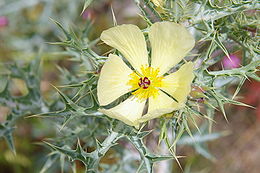
Argemone mexicanaArgemone mexicanaArgemone mexicana is a species of poppy found in Mexico and now widely naturalized in the United States, India and Ethiopia...Used by Chinese residents of Mexico during the early 20th century as a legal substitute for opium and currently smoked as a marijuana substitute. 
Ergine ErgineErgine, also known as d-lysergic acid amide , d-lysergamide, and LA-111, is an alkaloid of the ergoline family that occurs in various species of vines of the Convolvulaceae and some species of fungi...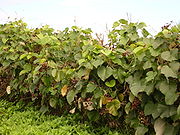
Argyreia nervosa (Hawaiian Baby Woodrose)Seeds contain high amounts of LSA (also known as d-lysergic acid amide, d-lysergamide, ergine, and LA-111), often 50-150X the amounts found in Ipomoea violacea Ipomoea violaceaIpomoea violacea is a perennial species of Ipomoea that occurs throughout the tropics, growing in coastal regions. It is most commonly called 'Beach Moonflower' or 'Sea Moonflower' as the flowers open at night...
.
Ibogaine IbogaineIbogaine is a naturally occurring psychoactive substance found in a number of plants, principally in a member of the Apocynaceae family known as Iboga . A hallucinogen with both psychedelic and dissociative properties, the substance is banned in some countries; in other countries it is being used...
Tabernanthe ibogaIbogaine in root bark
Ibogaine IbogaineIbogaine is a naturally occurring psychoactive substance found in a number of plants, principally in a member of the Apocynaceae family known as Iboga . A hallucinogen with both psychedelic and dissociative properties, the substance is banned in some countries; in other countries it is being used...
Tabernanthe orientalisIbogaine in root leaves
Ibogaine IbogaineIbogaine is a naturally occurring psychoactive substance found in a number of plants, principally in a member of the Apocynaceae family known as Iboga . A hallucinogen with both psychedelic and dissociative properties, the substance is banned in some countries; in other countries it is being used...
Tabernanthe pubescensIbogaine and similar alkaloids
Ibogaine IbogaineIbogaine is a naturally occurring psychoactive substance found in a number of plants, principally in a member of the Apocynaceae family known as Iboga . A hallucinogen with both psychedelic and dissociative properties, the substance is banned in some countries; in other countries it is being used...
TabernaemontanaTabernaemontanaTabernaemontana is a genus of 100-110 species of flowering plants in the family Apocynaceae. It has a pan-tropical distribution. These plants are shrubs and small trees growing to 1-15 m tall. The leaves are evergreen, opposite, 3-25 cm long, with milky sap; hence it is one of the diverse plant...
sp.Ibogaine Ibogaine IbogaineIbogaine is a naturally occurring psychoactive substance found in a number of plants, principally in a member of the Apocynaceae family known as Iboga . A hallucinogen with both psychedelic and dissociative properties, the substance is banned in some countries; in other countries it is being used...
Trachelospermum jasminoidesTrachelospermum jasminoidesTrachelospermum jasminoides is a species of flowering plant in the milkweed family, Apocynaceae, that is native to eastern and southeastern Asia, into Japan, Korea, southern China, and Vietnam. Common names include Star Jasmine, Confederate Jasmine, and Trader's Compass.-Description:Trachelospermum...Ibogaine
Aporphine AporphineAporphine is one of a class of quinoline alkaloids. Many different relatives of this compound have been purified from plants.One commonly-used aporphine derivative is apomorphine....
Nymphaea caeruleaNymphaea caeruleaNymphaea caerulea, also known as the Blue Egyptian water lily or sacred blue lily, is a water-lily in the genus Nymphaea.-Distribution:Its original habitat may have been along the Nile and other locations in East Africa...Recent studies have shown Nymphaea caerulea to have psychedelic properties, and may have been used as a sacrament in ancient Egypt and certain ancient South American cultures. Dosages of 5 to 10 grams of the flowers induces slight stimulation, a shift in thought processes, enhanced visual perception, and mild closed-eye visuals. Nymphaea caerulea is related to, and possesses similar activity as Nelumbo nucifera Nelumbo nuciferaNelumbo nucifera, known by a number of names including Indian Lotus, Sacred Lotus, Bean of India, or simply Lotus, is a plant in the monogeneric family Nelumbonaceae...
, the Sacred Lotus. Both Nymphaea caerulea and Nelumbo nucifera contain the alkaloids nuciferineNuciferineNuciferine is an alkaloid found within the plants Nymphaea caerulea and Nelumbo nucifera. It has a profile of action associated with dopamine receptor blockade. It induces catalepsy, it inhibits spontaneous motor activity, conditioned avoidance response, amphetamine toxicity and stereotypy...
and apomorphineApomorphineApomorphine is a non-selective dopamine agonist which activates both D1-like and D2-like receptors, with some preference for the latter subtypes. It is historically a morphine decomposition product by boiling with concentrated acid, hence the -morphine suffix...
, which have been recently isolated by independent labs.
These psychoactive effects make Nymphaea caerulea a likely candidate (among several) for the lotus plant eaten by the mythical Lotophagi in HomerHomerIn the Western classical tradition Homer , is the author of the Iliad and the Odyssey, and is revered as the greatest ancient Greek epic poet. These epics lie at the beginning of the Western canon of literature, and have had an enormous influence on the history of literature.When he lived is...
's OdysseyOdysseyThe Odyssey is one of two major ancient Greek epic poems attributed to Homer. It is, in part, a sequel to the Iliad, the other work ascribed to Homer. The poem is fundamental to the modern Western canon, and is the second—the Iliad being the first—extant work of Western literature...
.
Used in aromatherapyAromatherapyAromatherapy is a form of alternative medicine that uses volatile plant materials, known as essential oils, and other aromatic compounds for the purpose of altering a person's mind, mood, cognitive function or health....
, Nymphaea caerulea is purported to have a "divine" essence, bringing euphoria, heightened awareness and tranquility.
Other sources cite anti-spasmodic and sedative, purifying and calming properties.
Leonurine LeonurineLeonurine is one of the chemical constituents of the South African plant Leonotis leonurus. It is a psychoactive alkaloid found in species Leonotis nepetifolia, Leonotis artemisia as well as other plants of family Lamiaceae...
Leonotis leonurusLeonotis leonurusLeonotis leonurus, also known as Lion's Tail and Wild Dagga, is a plant species in the Lamiaceae family. The plant is a broadleaf evergreen large shrub native to South Africa and southern Africa, where it is very common. It is known for its medicinal and mild psychoactive...Both leaves and flowers (where most concentrated) contain Leonurine LeonurineLeonurine is one of the chemical constituents of the South African plant Leonotis leonurus. It is a psychoactive alkaloid found in species Leonotis nepetifolia, Leonotis artemisia as well as other plants of family Lamiaceae...
. (Effects reminiscent of marijuana)
Leonurine LeonurineLeonurine is one of the chemical constituents of the South African plant Leonotis leonurus. It is a psychoactive alkaloid found in species Leonotis nepetifolia, Leonotis artemisia as well as other plants of family Lamiaceae...
Leonotis nepetifoliaLeonotis nepetifoliaLeonotis nepetifolia, also known as Klip Dagga or Lion's Ear, is a species of plant in the Leonotis genus and the Lamiaceae family. While most other species in this genus are native to Southern Africa, L. nepetifolia is native to tropical Africa and southern India...Both leaves and flowers (where most concentrated) contain Leonurine LeonurineLeonurine is one of the chemical constituents of the South African plant Leonotis leonurus. It is a psychoactive alkaloid found in species Leonotis nepetifolia, Leonotis artemisia as well as other plants of family Lamiaceae...
. (Effects reminiscent of marijuana)
Active Chemical Unknown 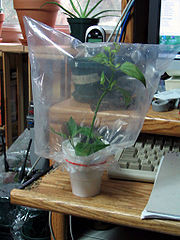
Calea zacatechichiCalea zacatechichiCalea zacatechichi, also known as Dream Herb, Leaf of God, and Bitter Grass, is a plant used by the indigenous Chontal of the Mexican state of Oaxaca for oneiromancy The plant naturally occurs from southern Mexico to northern Costa Rica...Produces vivid dreams after smoking. It is also employed by the Chontal people as a medicinal herb against gastrointestinal disorders, and is used as an appetizer, cathartic anti-dysentery remedy, and as a fever-reducing agent. Its psychedelic properties do not become apparent until the user is asleep. 
Unknown 
Silene capensisSilene capensisSilene capensis is a plant native to the Eastern Cape of South Africa, where it is regarded by the Xhosa people as a sacred plant...Produces vivid dreams after smoking.
ConvolvulaceaeConvolvulaceaeConvolvulaceae, known commonly as the bindweed or morning glory family, are a group of about 60 genera and more than 1,650 species of mostly herbaceous vines, but also trees, shrubs and herbs.- Description :...
:
Ipomoea tricolor Ipomoea tricolorIpomoea tricolor is a species of morning glory native to the New World tropics, and widely cultivated and naturalised elsewhere. It is a herbaceous annual or perennial twining liana growing to 2-4 m tall. The leaves are spirally arranged, 3-7 cm long with a 1.5-6 cm long petiole...
& Ipomoea violaceaIpomoea violaceaIpomoea violacea is a perennial species of Ipomoea that occurs throughout the tropics, growing in coastal regions. It is most commonly called 'Beach Moonflower' or 'Sea Moonflower' as the flowers open at night...
D-lysergic acid amide and lysergic acid amides in the seeds; up to 0.12% total
Rivea corymbosa Rivea corymbosaTurbina corymbosa Turbina corymbosa Turbina corymbosa ((syn. Rivea corymbosa), the Christmas vine, is a species of morning glory, native throughout Latin America from Mexico in the North to Peru in the South and widely naturalised elsewhere. It is a perennial climbing vine with white flowers, often...Seeds contain D-lysergic acid amide, lysergol LysergolLysergol, is an alkaloid of the ergoline family that occurs as a minor constituent in some species of fungi , and in the morning glory family of plants , including the hallucinogenic seeds of Rivea corymbosa , Argyreia nervosa and Ipomoea violacea. Lysergol is not a controlled substance in the USA...
, and turbicoryn; lysergic acid alkaloids up to 0.03%Some Mirabilis Mirabilis (plant)Mirabilis is a genus of plants in the family Nyctaginaceae known as the four o'clocks. The best known species may be Mirabilis jalapa, the plant most commonly called four o'clock....
sp. (Actually in Nyctaginaceae family)LSA
ApocynaceaeApocynaceaeThe Apocynaceae or dogbane family is a family of flowering plants that includes trees, shrubs, herbs, and lianas.Many species are tall trees found in tropical rainforests, and most are from the tropics and subtropics, but some grow in tropical dry, xeric environments. There are also perennial herbs...
family:- Catharanthus roseusCatharanthus roseusCatharanthus roseus is a species of Catharanthus native and endemic to Madagascar. Synonyms include Vinca rosea , Ammocallis rosea, and Lochnera rosea; other English names occasionally used include Cape Periwinkle, Rose Periwinkle, Rosy Periwinkle, and "Old-maid".In the wild, it is an endangered...
is (perhaps unpleasantly) "hallucinogenic." - Vinca minorVinca minorVinca minor, Lesser periwinkle and Dwarf periwinkle, is a plant native to central and southern Europe, from Portugal and France north to the Netherlands and the Baltic States, and east to the Caucasus, and also in southwestern Asia in Turkey...
Aquifoliaceae family:- Ilex guayusaIlex guayusaIlex guayusa is an Amazonian tree of the holly genus, native to the Ecuadorian Amazon Rainforest. One of three known caffeinated holly trees, the leaves of the guayusa tree are dried and brewed like a tea for their stimulative effects....
, which is used as an additive to some versions of AyahuascaAyahuascaAyahuasca is any of various psychoactive infusions or decoctions prepared from the Banisteriopsis spp. vine, usually mixed with the leaves of dimethyltryptamine-containing species of shrubs from the Psychotria genus...
. According to the Ecuadorian indigenous, it is also slightly hallucinogenic on its own, when drunk in high enough quantities.
EuphorbiaceaeEuphorbiaceaeEuphorbiaceae, the Spurge family are a large family of flowering plants with 300 genera and around 7,500 species. Most are herbs, but some, especially in the tropics, are also shrubs or trees. Some are succulent and resemble cacti....
family:- Alchornea floribundaAlchornea floribundaAlchornea floribunda is a plant native to Sudan, Uganda, Cameroon, Central African Republic, the Republic of Congo, Equatorial Guinea , Gabon, São Tomé and Príncipe, the Democratic Republic of Congo, Côte d'Ivoire, Ghana, Guinea, Liberia, Nigeria and Sierra Leone...
, YohimbineYohimbineYohimbine is an alkaloid with stimulant and aphrodisiac effects found naturally in Pausinystalia yohimbe . It is also found naturally in Rauwolfia serpentina , Alchornea floribunda , along with several other active alkaloids...
Loganaceae family:- Desfontainia spinosa, causes visions
LythraceaeLythraceaeLythraceae are a family of flowering plants. It includes about 620 species of mostly herbs, with some shrubs and trees, in 31 genera. Major genera include Cuphea , Lagerstroemia , Nesaea , Rotala , and Lythrum...
family:- Heimia myrtifolia, auditory
- Heimia salicifoliaHeimia salicifoliaHeimia Salicifolia is a species of flowering plant in the Loosestrife family, Lythraceae. It is native to the Americas, ranging from the southwestern United States through Mexico and Central America to Argentina...
, auditory
See also
- Aztec entheogenic complexAztec entheogenic complexThe ancient Aztecs employed a variety of entheogenic plants and animals within their society. The various species have been identified through their depiction on murals, vases, and other objects...
- Entheogenic drugs and the archaeological recordEntheogenic drugs and the archaeological recordEntheogenic drugs have been used by various groups for thousands of years. There are numeroushistorical reports as well as modern, contemporary reports of indigenous groups using entheogens.-New World:...
- God in a Pill?God in a Pill?God in a Pill? was a 1966 pamphlet by Meher Baba in which he spoke out strongly against taking illicit drugs like marijuana and LSD, saying they were harmful "physically, mentally, and spiritually."...
- List of Entheogens
- List of poisonous plants
- List of plants used for smoking
- Louisiana State Act 159Louisiana State Act 159Signed into law June 28, 2005 and effective August 8, 2005, Louisiana State Act No 159 found in, Louisiana RS 40:989.1, outlawed the cultivation, possession or sale of 40 known hallucinogenic plants in the state of Louisiana...
- Psychoactive cactiPsychoactive cactiMany cacti are known to be psychoactive, but the two main psychoactive cacti are Trichocereus or "San Pedro" and Lophophora or "Peyote".-"Peyotes" and other Psychoactive and/or Medicinal Cacti:"True Peyote" = Lophophora williamsii"Other Peyotes"...
- Psilocybin mushrooms
- Table of psychedelic plants and fungi
External links
- The Salvia Divinorum Blog Research And Information
- The Salvia Divinorum Mass Distribution Project
- Descriptions of psychoactive Cacti. Lycaeum Visionary Cactus Guide
- "Herbal Highs – Legal Buds Reviews" Components of street drug alternatives sold and used legally.
- Erowid Tryptamine FAQ – More Plants Containing Tryptamines
- John Stephen Glasby, Dictionary of Plants Containing Secondary Metabolites, Published by CRC Press
- Golden Guide to Hallucinogenic Plants
- Hallucinogens on the Internet: A Vast New Source of Underground Drug Information John H. Halpern, M.D. and Harrison G. Pope, Jr., M.D.
- http://www4.gu.edu.au:8080/adt-root/uploads/approved/adt-QGU20070710.160928/public/02Whole.pdf– Peter L. Katavic, Chemical Investigations of the Alkaloids From the Plants Of The Family ElaeocarpaceaeElaeocarpaceaeElaeaocarpaceae is a family of flowering plants. The family approximately contains 605 species of trees and shrubs in 12 genera. The largest genera are Elaeocarpus, with about 350 species, and Sloanea, with about 150....
], School of Science/Natural Product Discovery (NPD), Faculty of Science, Griffith University - Alexander T. Shulgin, Psychotomimetic Drugs: Structure-Activity Relationships
- UNODC The plant kingdom and hallucinogens (part II)
- UNODC The plant kingdom and hallucinogens (part III)
- Virola – Dried Herbarium Specimens
- Virola Species Pictures – USGS
- Desmanthus illinoensis – USDA
- A General Introduction to Ayahuasca
- Psychedelic Reader (Google Books)
- Fagonia cretica
Mescaline
Species, Alkaloid Content (Fresh) - Alkaloid Content (Dried)Beta-carbolines
.svg.png)
Beta-carboline
β-Carboline is an organic amine that is the prototype of a class of compounds known as β-carbolines.-Pharmacology:...
s are "reversible" MAO-A inhibitors. They are found in some plants used to make Ayahuasca
Ayahuasca
Ayahuasca is any of various psychoactive infusions or decoctions prepared from the Banisteriopsis spp. vine, usually mixed with the leaves of dimethyltryptamine-containing species of shrubs from the Psychotria genus...
. In high doses the harmala alkaloids are somewhat hallucinogenic on their own.

